As longtime followers know, most of our volunteers work from home. I am not an exception. My home is a geographical oddity – three hours from everywhere. Last week saw visits to both the hangar and to Fred Bieser, the turret restoration expert. It was exhausting but worth it!
First up is some progress in rebuilding the turrets for Lucky Thirteen.
Thanks to generous donations from our supporters, we were able to purchase the ball turret’s suit heater rheostat and oxygen regulator assembly, as well as the cover plate for the ball turret’s newly acquired brush assembly. The ball turret gunner’s suit heater rheostat and oxygen regulator were mounted underneath the airman’s armored seat plate. Fred was unwilling to sell his one remaining seat plate without a larger package deal, so we had to leave it behind for now. That said, we have a tracing of the plate itself and can easily cut out a new one if provided the correct material: rolled homogenous armor (RHA) steel at .25” thick.
Now that the cover plate for the brush assembly is here, we can begin restoring this vitally important piece. The brush assembly is where the turret receives electrical power from the aircraft. (It is a myth that the turrets were hydraulically powered.)
While visiting, Fred took the time to replace the missing bits to the Type K-3 Gunsight for the bomber’s Type A-1 Upper Turret. We hope to build a display for this sight so that visitors can see how it works while restoration of the turret itself continues.
Turret parts are not cheap, and we cannot thank you enough for your support in rebuilding the A-1 Upper and A-2 Lower Turrets for Lucky Thirteen. If you can be of any help – providing parts, financially contributing, etc. – please do not hesitate to do so!
The next day saw a visit to the hangar from our friend Chris Hrabina and his family. Chris contributed a box of gauges and while there I took the time to take some pictures of the recent projects there. Hope you enjoy!
Lastly, we wanted to share some recent acquisitions:
We finally have the last of the manuals which apply to Lucky Thirteen! The last piece to come in was the Boeing B-17F’s Field Service Manual. This is a small, thick book bound in soft leather, similar in appearance to the manuals which come with modern automobiles. F-model B-17 service manuals were brown; G-model B-17 service manuals were blue. With this major hurdle crossed, the only piece missing from this collection is the B-17F’s flight computer – a cardstock piece with various pull-tabs used for quick calculations. If any of you can help with this need, please let us know!
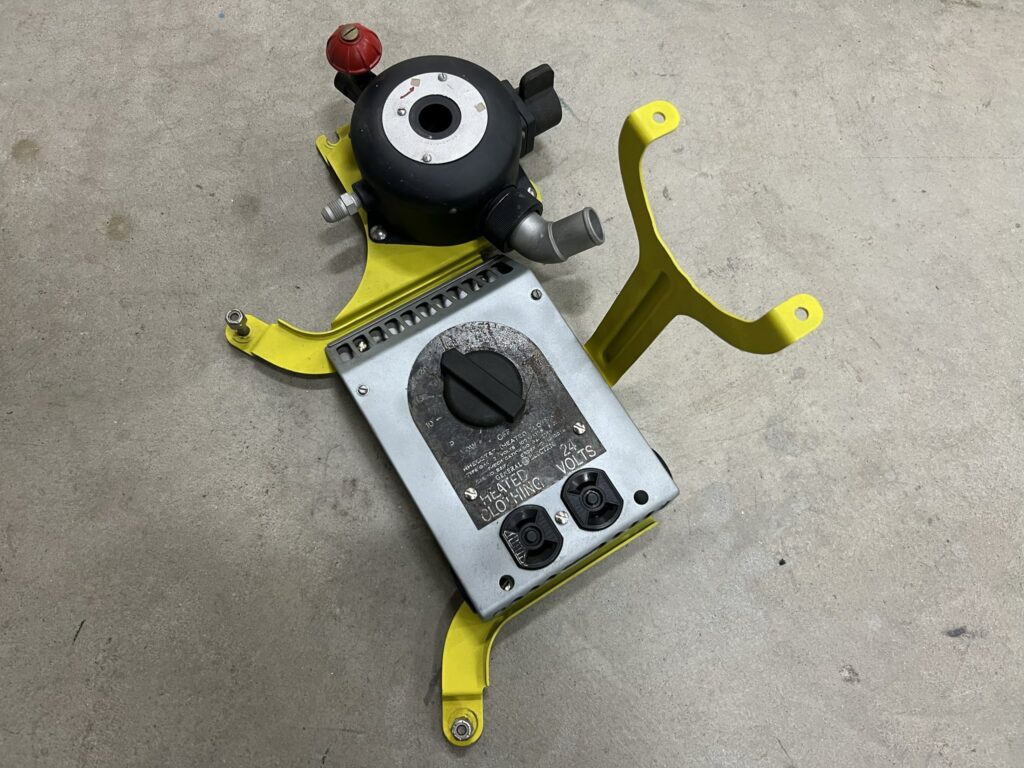
The newly acquired oxygen regulator and suit heater rheostat for the Type A-2 ball turret.
The types shown here General Electric Q-1A Suit Heater and Bendix Pioneer A-12 Regulator are those correct for Lucky Thirteen. So if you have any that you can spare for the project, please let us know!
Frustratingly, Aro type regulator fittings are not interchangeable with Pioneer ones.
Photo taken 12 July 2023.
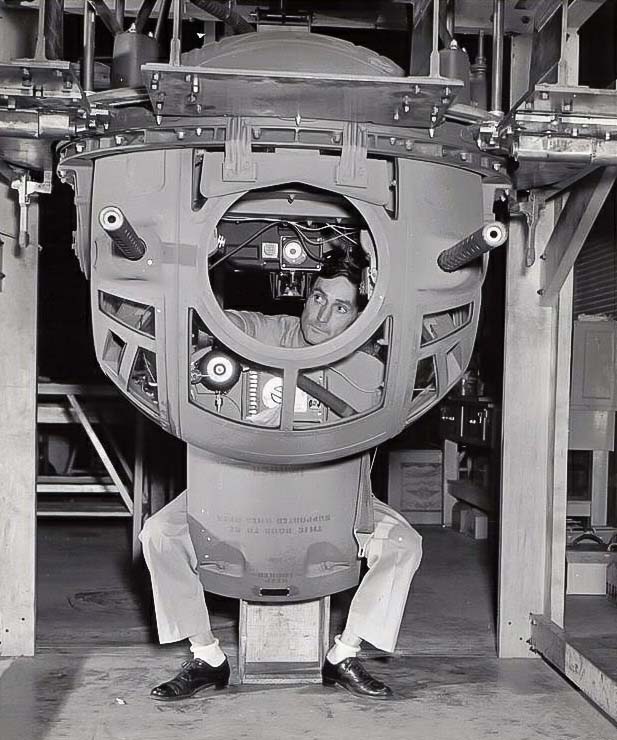
A Briggs type ball turret undergoing inspection.
This photo was taken at the Douglas Aircraft factory in Tulsa, Oklahoma, which produced some 962 Consolidated B-24s under license during the war. Note the fire cut-off cam above the center window – a clear indicator that this turret is intended for a B-24. Douglas was the only company to produce both the Boeing B-17 and Consolidated B-24 under license.
The oxygen regulator and suit heater rheostat are visible on the bottom of the gunner’s armor seatplate.
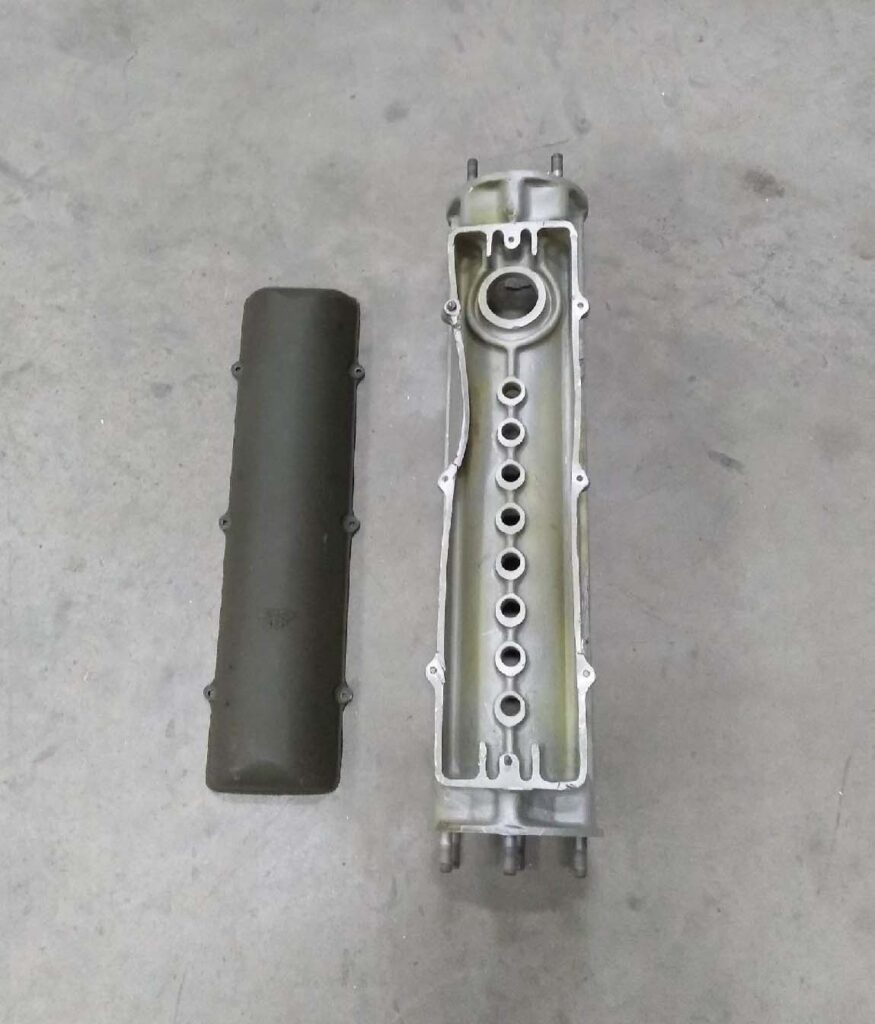
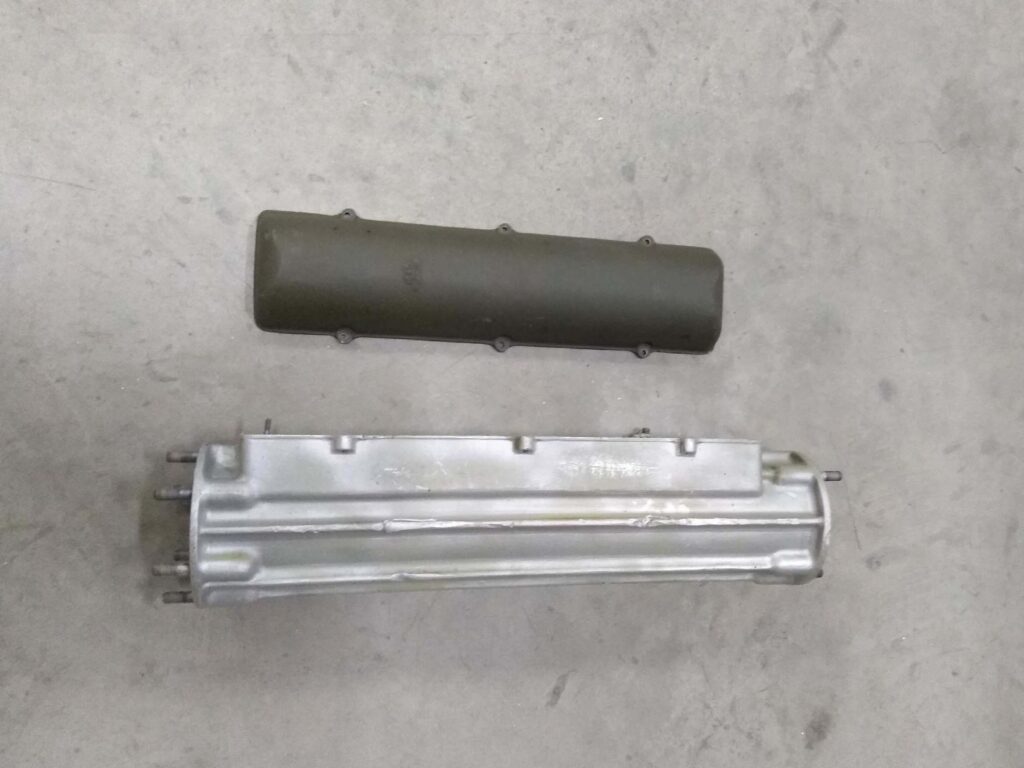
The newly arrived ball turret brush plate cover along with the brush assembly housing.
The large brush housing was unique to the Type A-2 Ball Turrets found on E and F-model B-17s. The Type A-2A Ball Turret had a far smaller hanger assembly.
The housing is already undergoing restoration, being disassembled and stripped of paint. The next step will be to remove the dent from its midair collision.
Photo taken 17 July 2023.

A manual illustration of a Type A-2 Ball Turret.
The brush assembly has been highlighted in red.
The hanger and trunnion assembly has been highlighted in blue. A trunnion/hanger has been offered to us for the price of 25,000 USD, if we can raise the money.

Manual illustration of the brush and hanger assembly. The retainer mounting plate is missing from our brush assembly.
The secret to the turret’s power is the collector ring assembly: the long tube piece on the far right.
Power from the airplane goes to this piece, which is then picked up by wires which ‘brush’ against the rings. This gives the turret power while allowing it to move unencumbered.
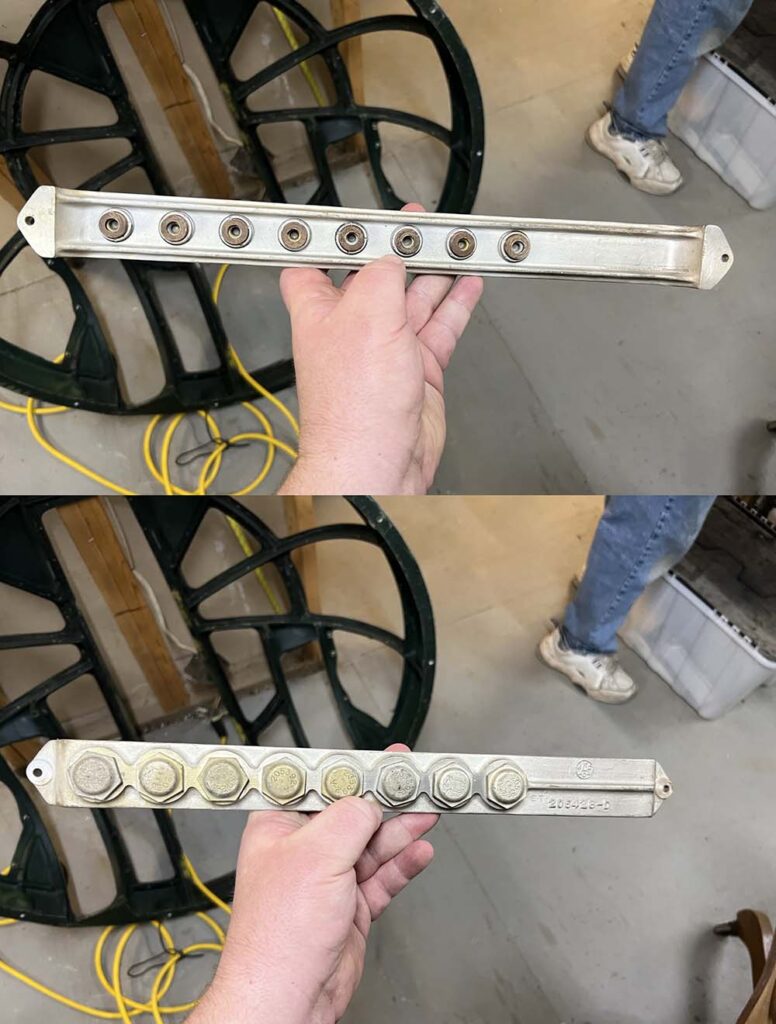
Front and back photos of a ball turret’s retainer mounting plate in Fred’s collection.
If you can help with this need, please let us know!

Hangar Thirteen’s ball turret brush assembly (right) with the one in Fred’s collection.
Fred’s brush assembly comes from an Emerson-built turret while our example comes from a Briggs-built turret. Note the difference in bronze green vs. olive drab paint.
Photo taken 11 July 2023.

A manual photo showing the Type A-2 Ball Turret aboard a Boeing B-17E. The fact that this is an E-model can be ascertained by the lack of armor plating around the waist gun windows.
The large conduit which runs from the hanger to the ball is visible here, as is the brush assembly’s cover plate.
The box on the hanger assembly is a spare parts/accessory box. If you have access to one of these, please let us know!
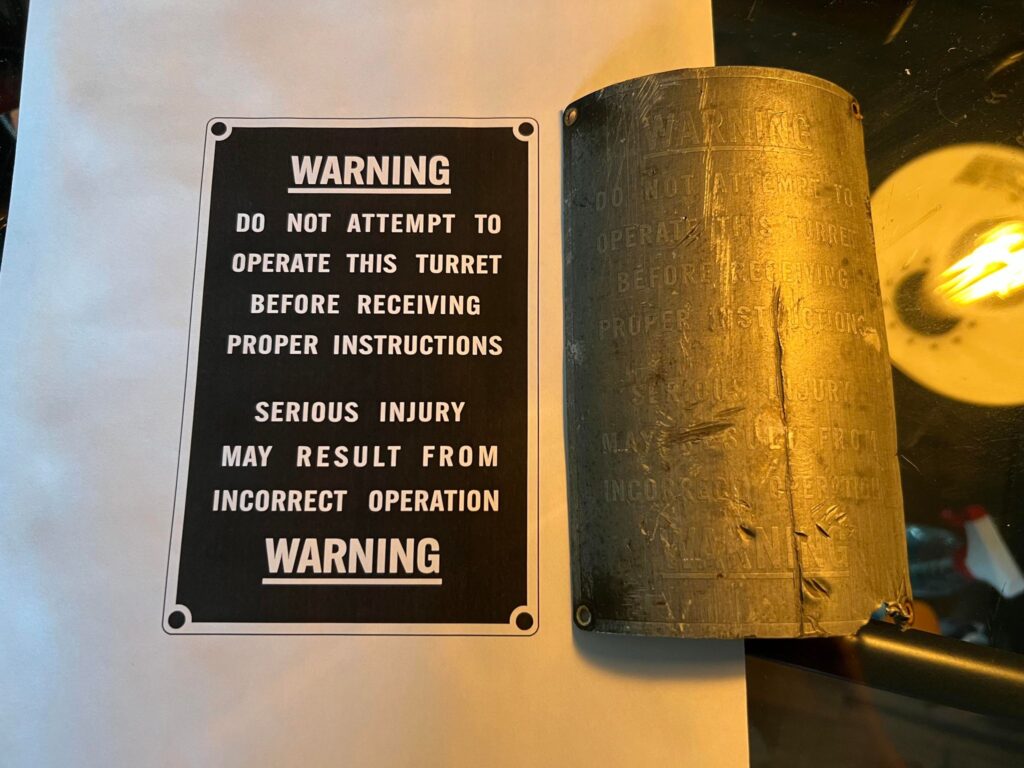
Progress recreating the warning placard originally found on the Type A-2 Ball Turret’s brush assembly cover.
The turret’s dataplate was also found on this cover, though it was missing from our example.
Photo taken 16 July 2023.
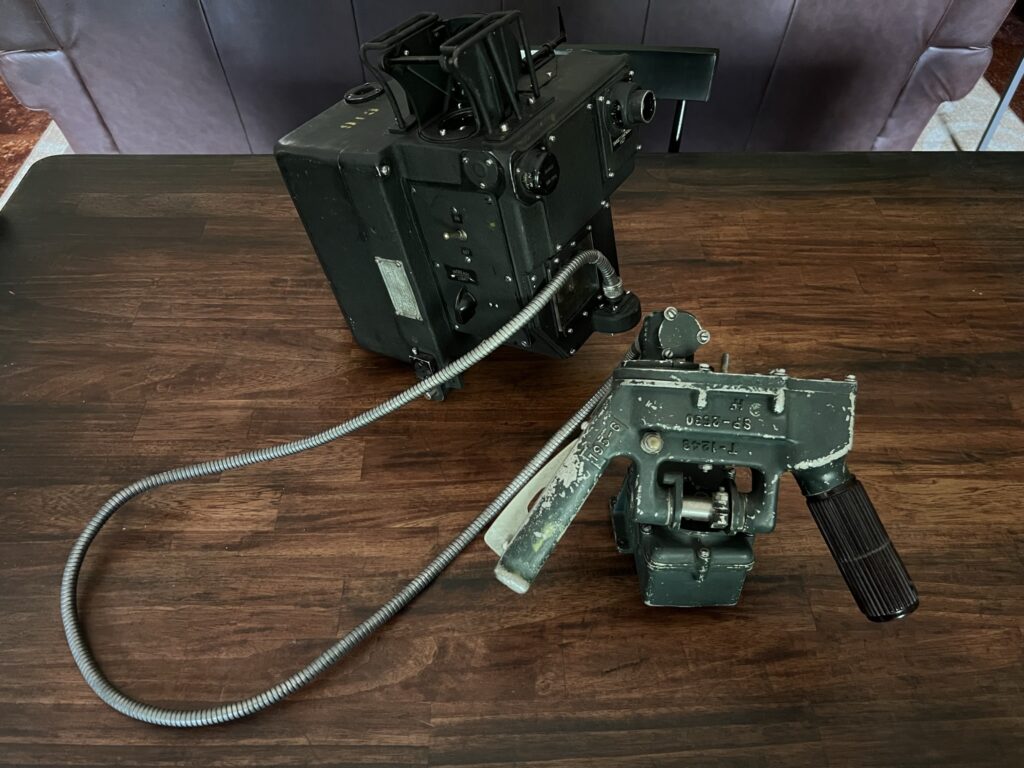
The fully-restored Type K-3 gunsight, connected to the top turret’s hand control assembly.
The turret calculated target lead by drive cables which inputted the turret’s elevation, position in relation to the aircraft, and the range of the target. Range was calculated by the gunner manually entering the target’s wingspan and adjusting the reticule to visually bracket the fighter.
Tuning cables are used everywhere throughout the aircraft, so we can always use more!
Photo taken 17 July 2023.
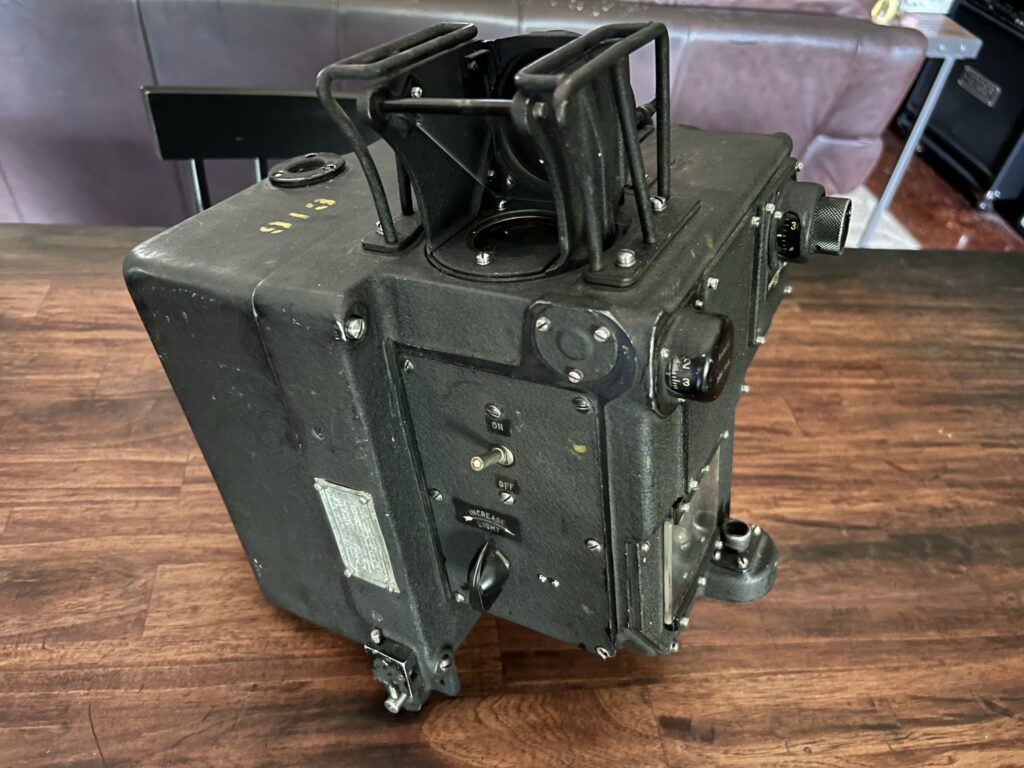
The fully restored Type K-3 gunsight.
This example is an older unit as later war K-3s had recessed control panels.
Special thanks to David Green of Ventura, California for providing the replacement lens assembly!
Photo taken 17 July 2023.
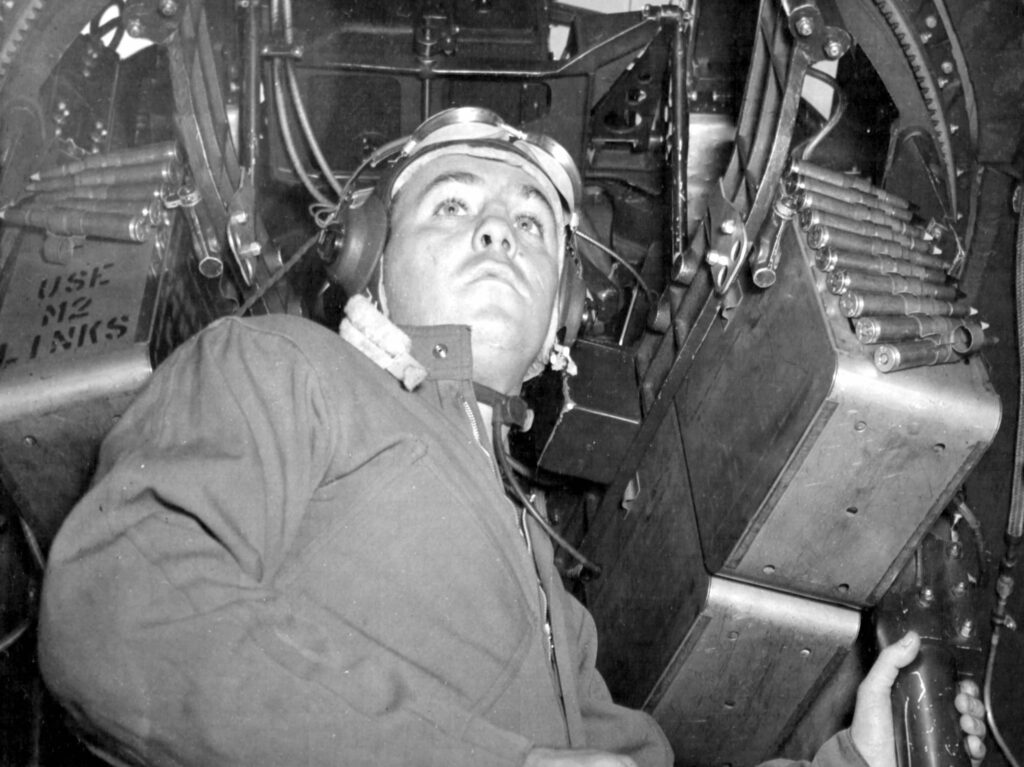
An airman poses with the Type A-1 Upper Turret aboard Hell’s Angels (41-24577, 303BG). The Type K-3 Gunsight can be seen above.
The stainless steel ammunition cans on either side held 133 rounds each. Later models were galvanized. The Types A-1 and A-1A Upper Turrets carried six ammo cans each. The late-war A-1B carried a pair of 700 magazines for its guns.
If you can help with the early-style ammo cans for Lucky Thirteen, please let us know!
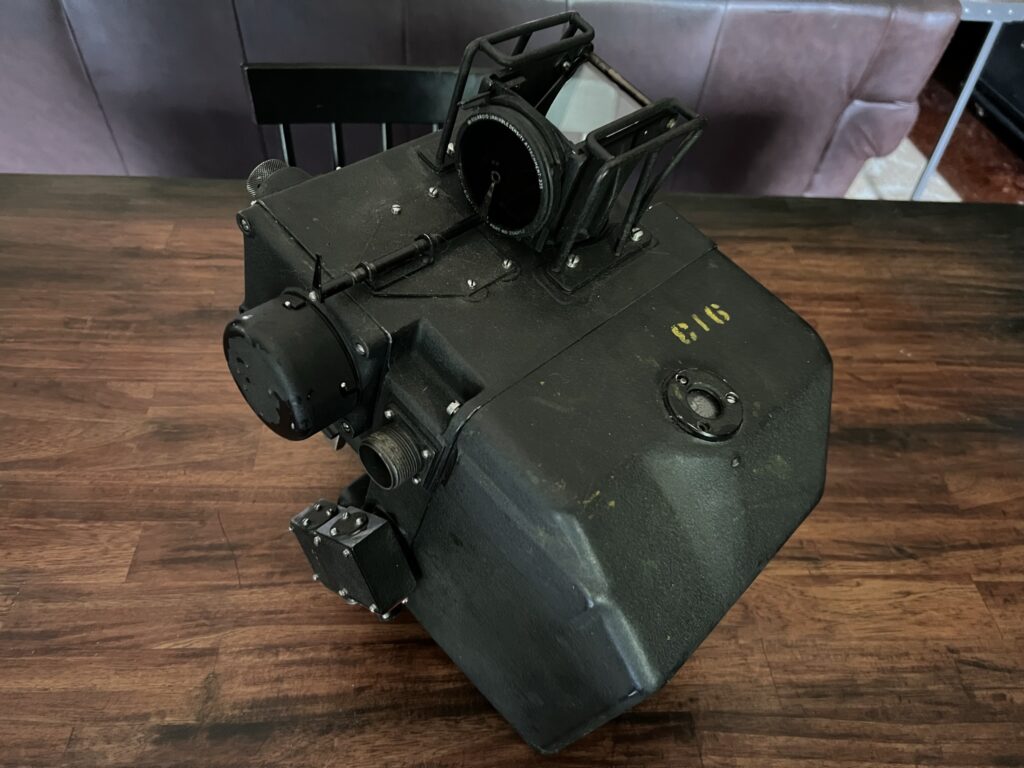
The fully restored Type K-3 Gunsight.
The round lens seen above is a sunscreen for the lens, the opaqueness of which is adjustable.
The two square boxes on the front are inputs for the cables transferring azimuth and elevation data. One of these boxes was missing from our example and was replaced with Fred’s help.
Photo taken 17 July 2023.

Airman of the 306BG pose with an early-variant Type K-3 Gunsight.
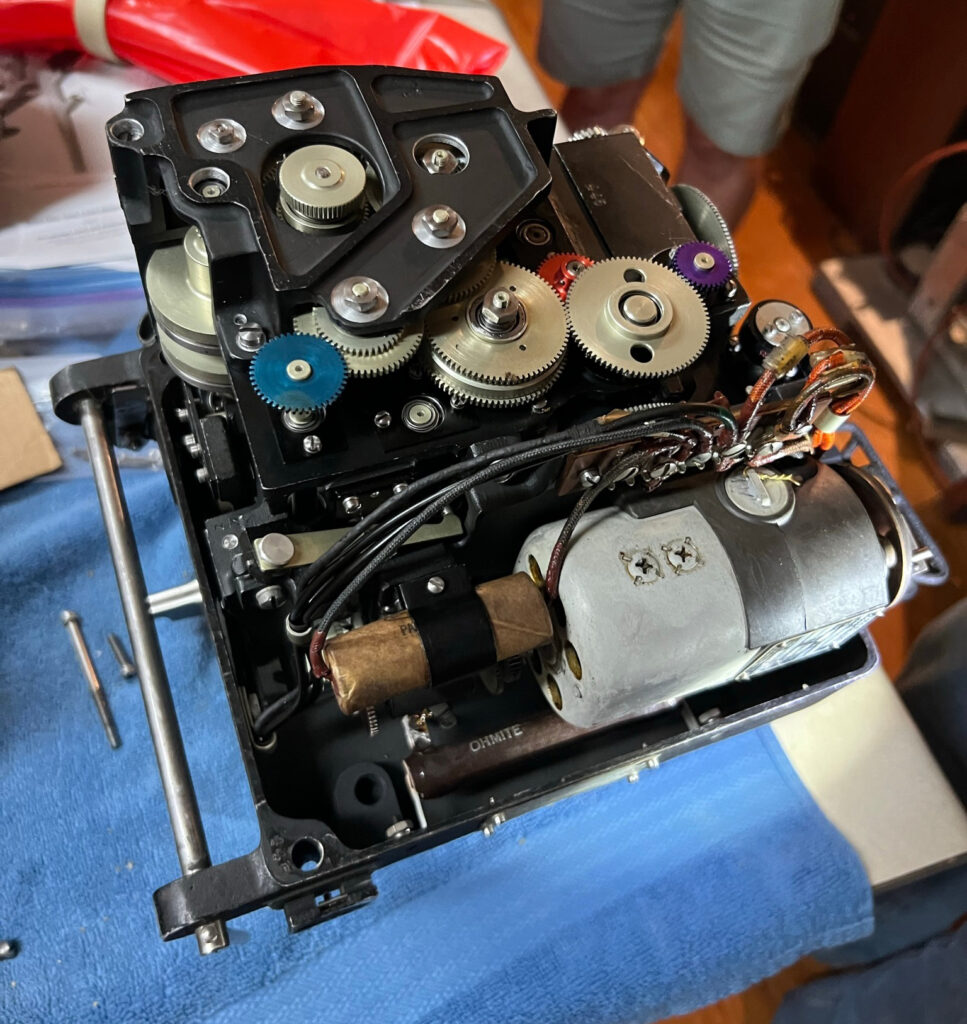
Lucky Thirteen‘s Type K-3 Gunsight with its cover removed.
Photo taken 11 July 2023.
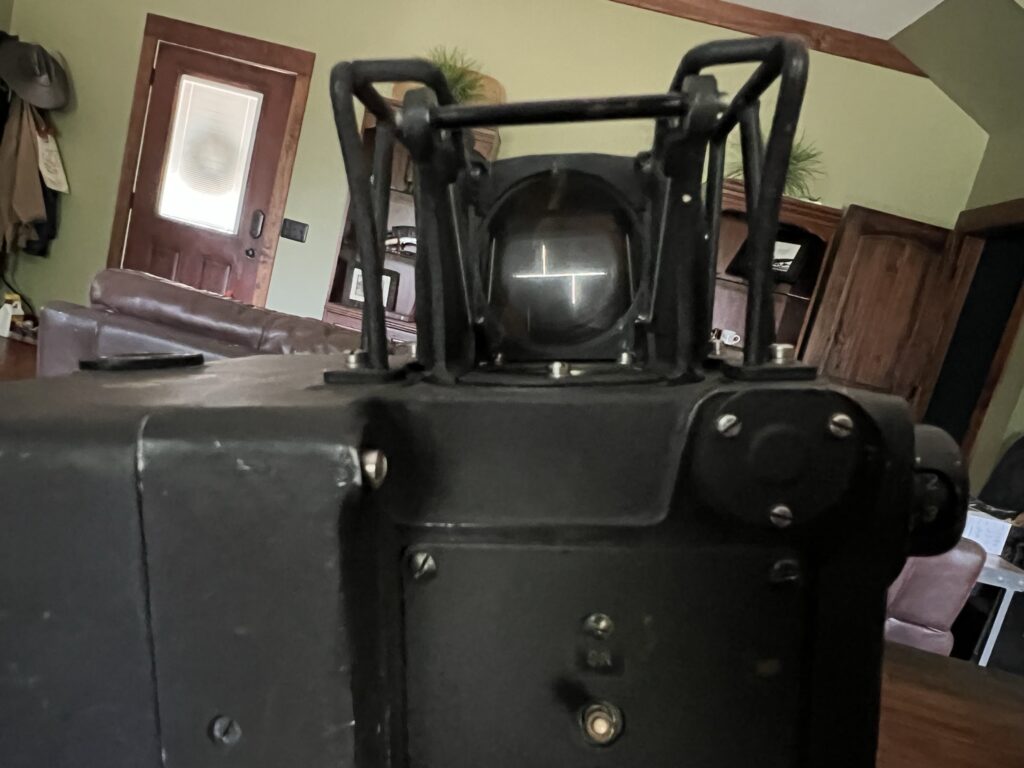
Viewing the reticule with the light turned on. The sight calculated range by manually inputting the target’s wingspan ahead of time, then adjusting the reticule to bracket the interceptor. Since the gunsight was connected to the turret, this information was used to automatically calculate lead.
As such, the gunner did not have to lead his target – the gunsight did it for him.
Photo taken 17 July 2023.

The manuals for Lucky Thirteen. The newly arrived service manual is at the bottom.
Photo taken 7 July 2023.

Station 11 (the rearmost fuselage bulkhead) of Lucky Thirteen awaits painting. In the meantime, it is placed back into its original location.
Photo taken 12 July 2023.

Station 10 of Lucky Thirteen likewise awaiting painting.
Note the phenolic pieces which the rudder cables run through.
Photo taken 12 July 2023.
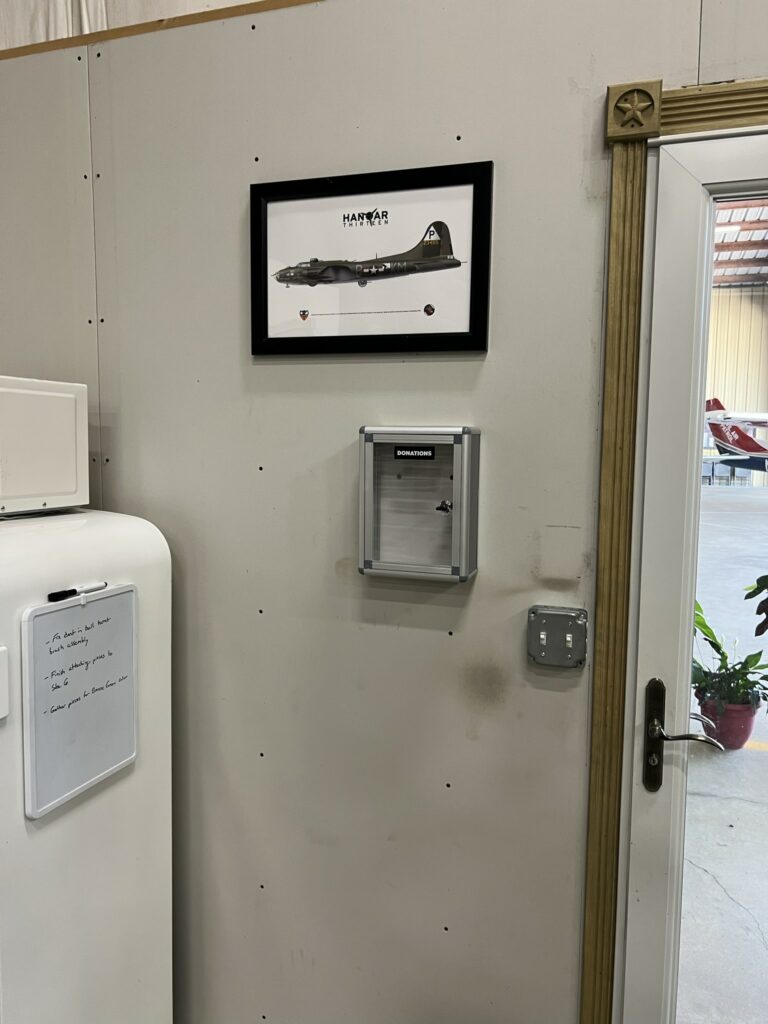
Something we have been needing for a long time:
The hangar now has a donation box!
Photo taken 12 July 2023.
Our friend Eric of Project Warbird has recently acquired Consolidated LB.30 Liberator II AL557!
The LB.30 was an early variant of the B-24 intended for Lend Lease. LB.30 AL557 saw service with Britain’s Royal Air Force, flying with 120 Squadron (Coastal Command) and 159 Squadron (Southeast Asia Command). Converted into a transport toward the end of the war, AL557 was briefly used as an airliner in Greece, where she was christened the Maid of Athens.
Project Warbird and Hangar Thirteen are partnering in this endeavor, as we have always worked closely on another’s projects. The forward fuselage of Maid of Athens is now safely at our hangar, where we will build her jig for Eric to begin restoration.
If any of you wish to take part in the rebuild of Lucky Thirteen or Maid of Athens, just let us know! Right now, the biggest need for the LB.30 is reference material. If any of you work in US or British archives, blueprints and documentation regarding the LB.30’s construction (in the US) and modifications (in the UK) would be most helpful. We wish to be as accurate as we possibly can in rebuilding this old bomber.
We have completed restoration of our first Type A-17 Fire Extinguisher for Lucky Thirteen.
The Boeing B-17 was equipped with three CO2 and two carbon tetrachloride fire extinguishers as standard. The three CO2 units were either Type A-17s or 4TBs, both designed by Kidde of New Jersey, the inventor of the portable CO2 extinguisher. The 4TB was the latter design, using the same cylinder as the A-17 but equipped with a pistol grip rather than a folding lock arm. As such, not only are A-17s more typical of early-war aircraft, they are also considerably more difficult to find.
This unit was donated by Joe McKowen of Gaffney, South Carolina and manufactured under license by Kelsey Hayes Wheel of Livonia, Michigan in December 1943. The stencils indicated that it was last inspected in August 1945. Heather Davenport and the students at Creekside High School in St. Johns, Florida reverse engineered the broken horn assembly so that a new 3D printed horn could be made. Likewise, the original stenciling was carefully traced and scanned into the computer so that it too could be faithfully recreated. With the recent help from Howard Lawson of the Virtual WWII B-17G Bomber Project in recreating the mounts, the first CO2 extinguisher for Lucky Thirteen is ready for installation!
Next is a donation from our friend Mark Lewis of Beaver Mountain Leather Works in Canada. Mark recently finished recreating the seat and knee pads for the tail gun position on Lucky Thirteen.
On any aircraft, the tail position is quite turbulent, and the B-17’s tail section was heavily padded to account for this. The tail gunner sat on his knees, his bottom resting on a large bicycle-shaped seat which could be angled like an ironing board. Pads kept him from poking his sides on the ammunition boxes, with similar pads protecting his shoulders from the canopy. Yet another pad was placed on the armor plate upon which he rested his chest.
With the recent arrival of these pads, there is nothing stopping us from recreating the tail gunner seat for the tail stinger. First up will be recreating the metal components for said seat. Since our volunteers are all busy with their own projects, this might be a fun opportunity for anyone out there interested in volunteering from home!
The biggest news for Lucky Thirteen over the past week is that the recent trip to retrieve the first bits of Maid of Athens also resulted in the discovery of several B-17 parts.
Eric was able to acquire for us a pilot’s seat, the radio room hatch window, four sets of cowl rings, and several sets of landing gear components. One particularly surprising find was the missing station from our stinger assembly, which was used to attach the stinger to the fuselage at Station 11. These finds are absolutely amazing and are a huge step forward for Lucky Thirteen.
Speaking of Eric, he has begun the process of backdating Maid of Athens to her original wartime configuration. The original cargo-door nose has been removed and her interior thoroughly cleaned. As such, she has been brought indoors where we can begin work on building her a jig.
A very special thanks to Joe, Kevin, Howard, Mark, and Eric for these amazing pieces!

The newly restored Type A-17 Fire Extinguisher for Lucky Thirteen. One down, two to go.
At first aircraft CO2 extinguishers were unpainted, though this was later changed to light gray. The gray on this unit has been color-matched to an untouched portion of the extinguisher.
Photo taken 20 June 2023.
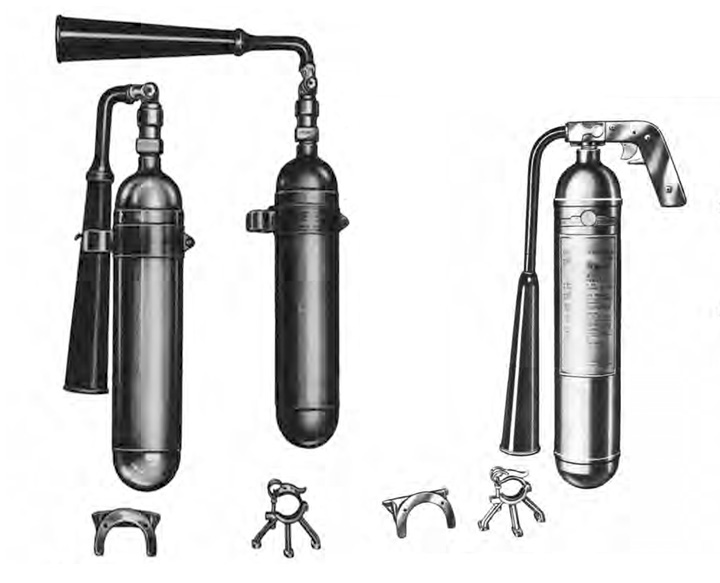
A visual comparison between the A-17 and the 4TB as shown in the Army index.
To fire the A-17, the elbow was raised at a 90 degree angle. To halt the firing, the elbow was pulled all the way back.

The radio compartment’s A-17 extinguisher is highlighted in this photo from a Boeing B-17F slightly older than Lucky Thirteen.

The A-17 as donated, along with a test print of the traced stenciling.
Photo taken 8 February 2023.
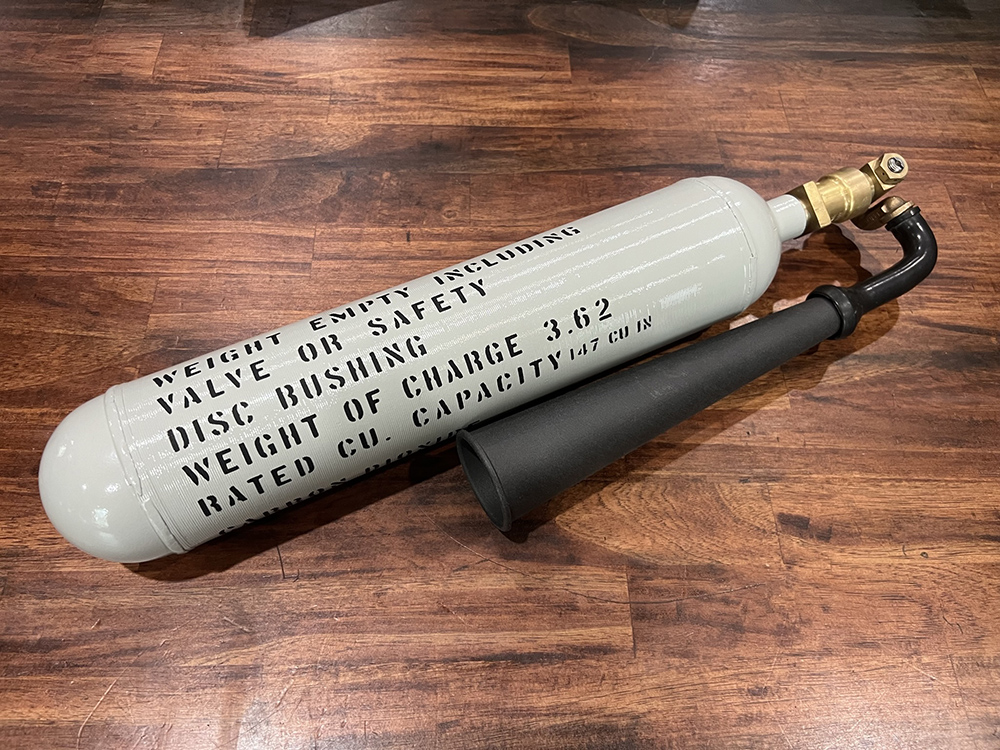
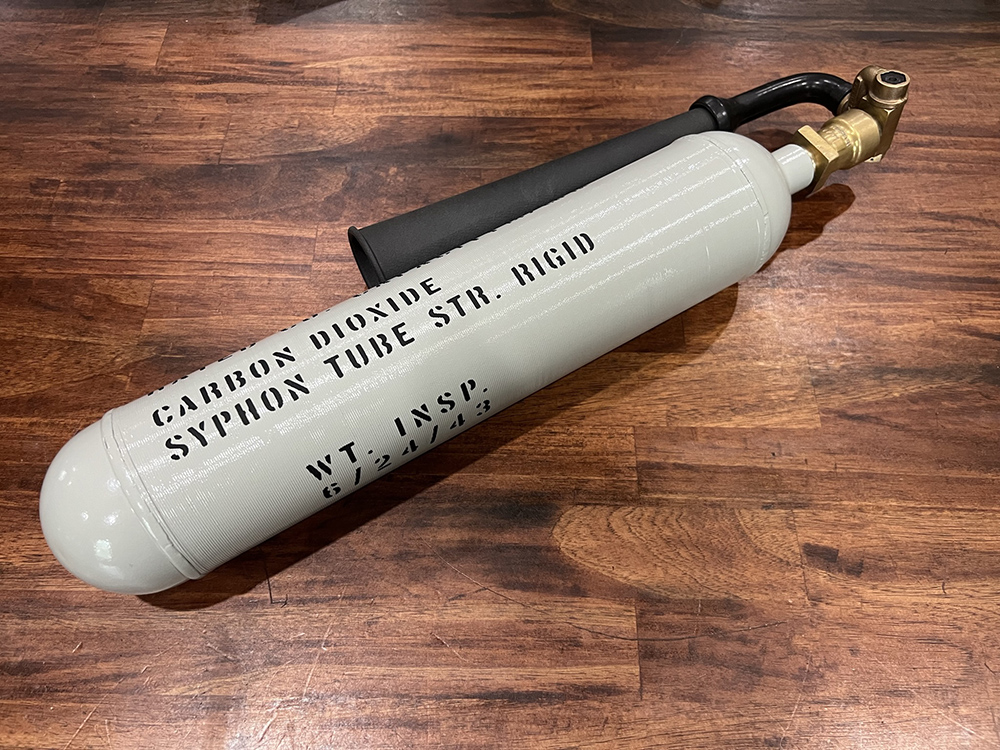
The newly restored A-17 with its brass band removed.
We did something a little cheeky: the latest inspection date is now the day Lucky Thirteen entered service.
Photo taken 20 June 2023.

The newly arrived tail gunner seat and kneepads.
Photo taken 8 June 2023.
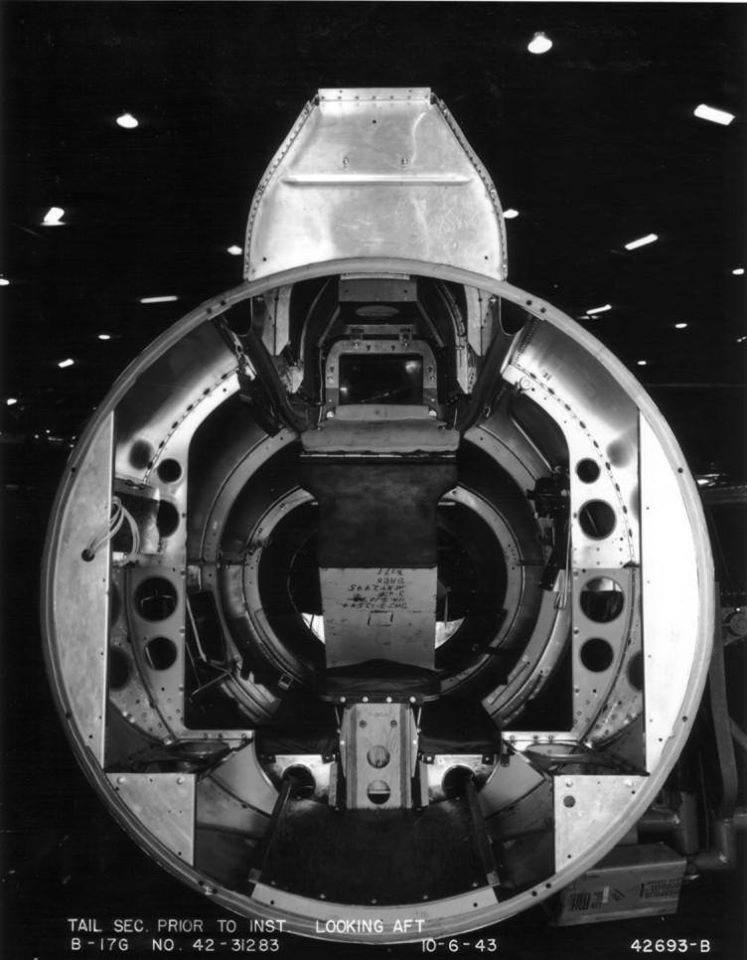
The tail gun position of 42-31283, a Boeing B-17G that never left the states.
The ammo boxes have not been installed yet, though you can see where they would later be located. The gunner sits on the bicycle seat, his knees on the padding and his chest against the armor plate.
Photo taken 10 June 1943.
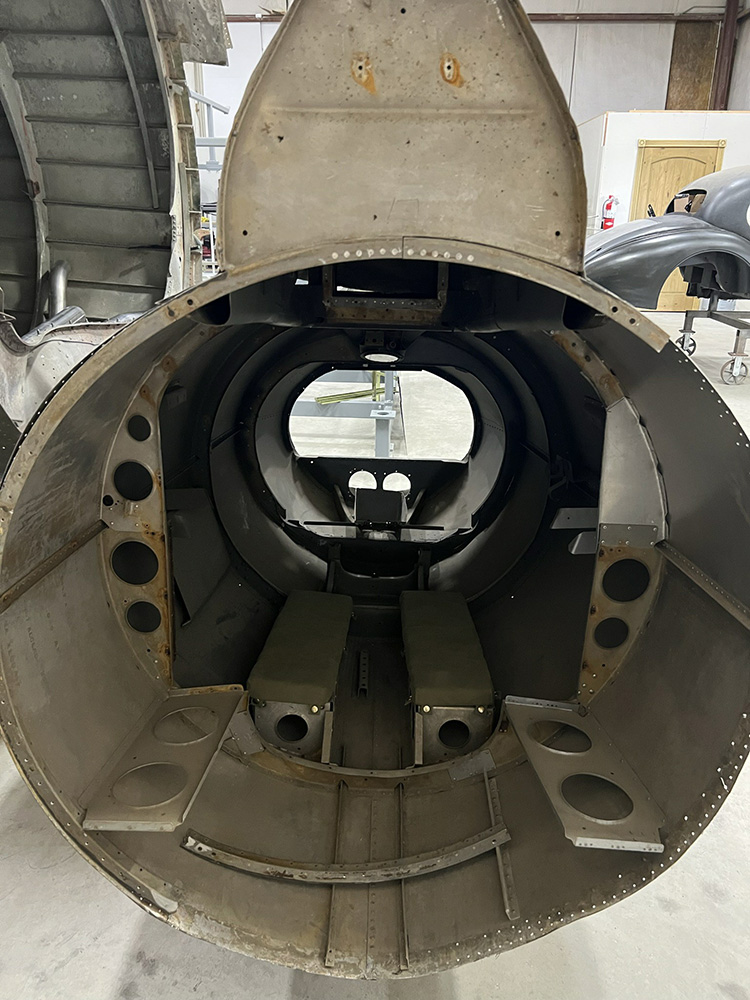
Mark’s newly donated kneepads fit perfectly into the stinger for Lucky Thirteen.
Photo taken 28 June 2023.
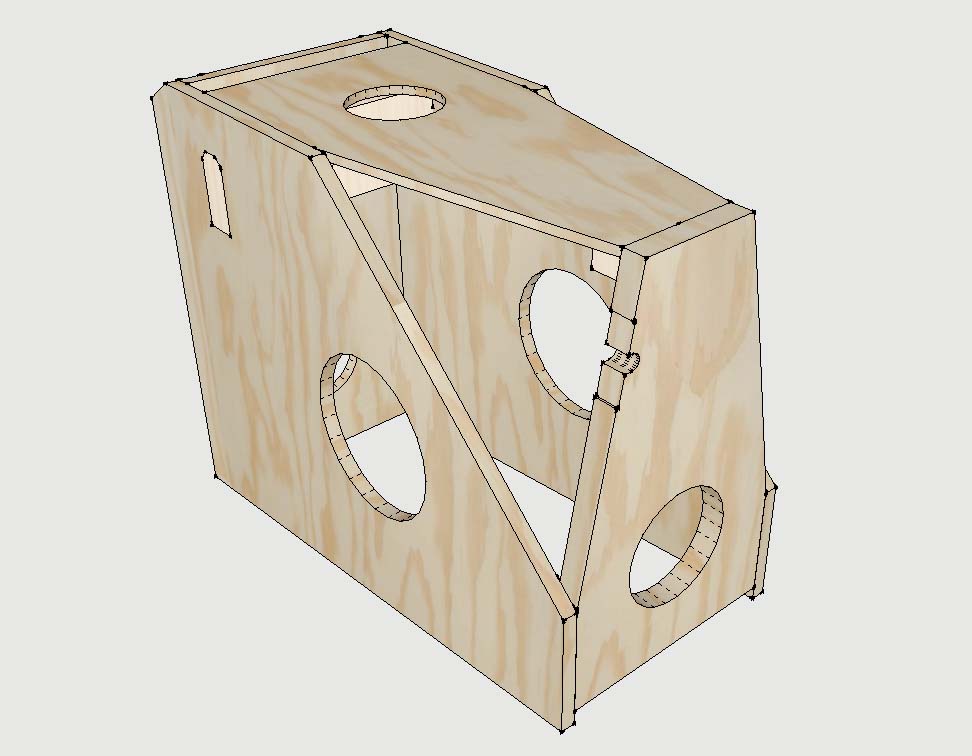
A 3D rendering of the tail gunner’s seat assembly is made to help visualize the blueprints. The metal components have not been rendered.
The seat itself is attached to this assembly with a hinge. A spring lever adjusts the angle of the seat, while another spring lever slides the assembly back and forth.
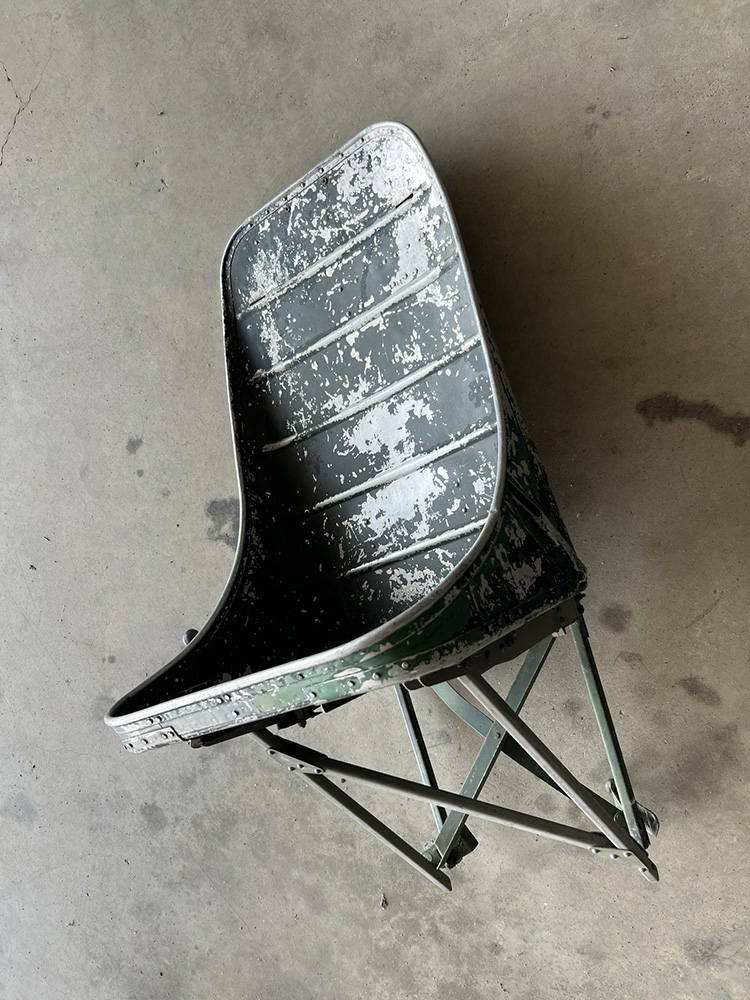
Eric’s newly donated pilot’s seat.
An undisclosed friend of Hangar Thirteen has offered to donate a second pilot seat whenever he comes to visit from out West. When he does, we will have both pilot seats for Lucky Thirteen!
Photo taken 28 June 2023.

2LT Fred W. Dallas and 2LT John H. Holmes pose in the cockpit of a Boeing B-17E at MacDill Field in Tampa, Florida.
This photo was from a Life magazine series documenting bomber crew training in 1942.

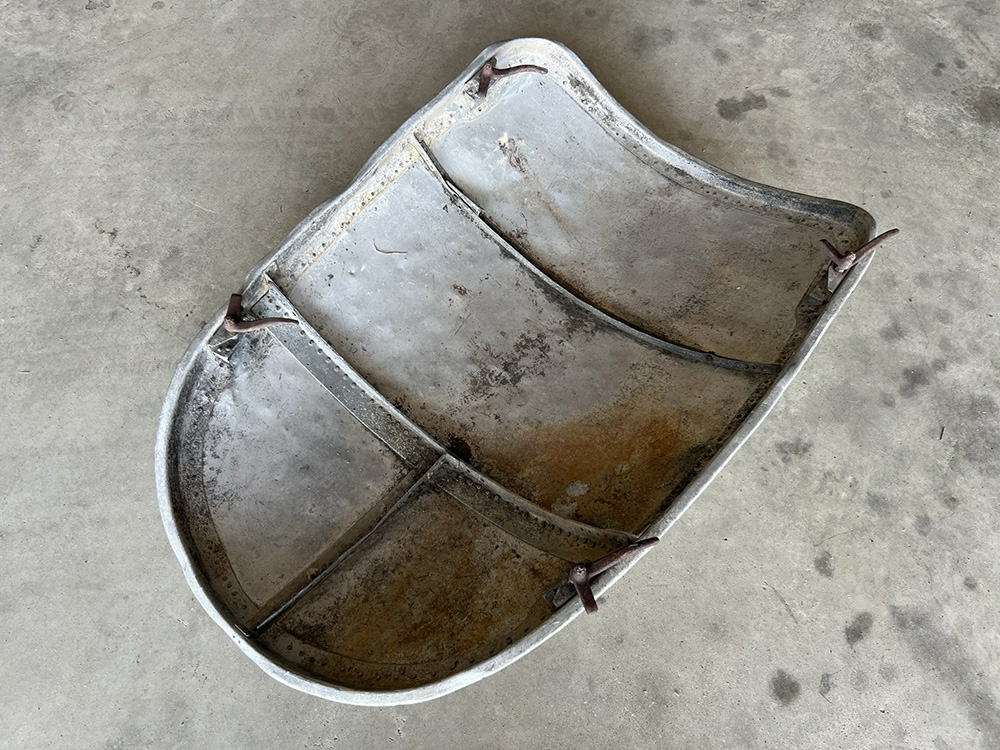
Eric’s newly donated radio room hatch cover.
The plexiglass window that goes here has been replaced with a sheet of aluminum.
Photo taken 28 June 2023.
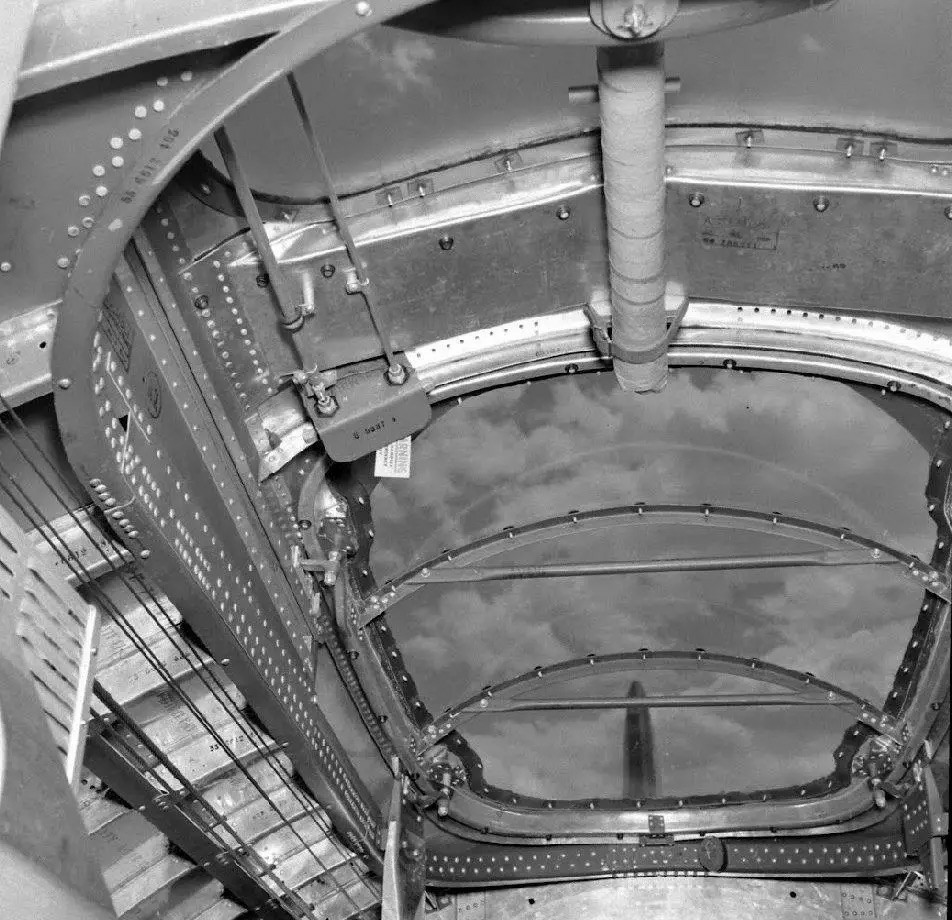
The radio room hatch cover aboard Phyllis (42-97825) prior to removal at the United Airlines Modification Center in Cheyenne, Wyoming.
This photo was part of a Life magazine series documenting the changes made to Boeing B-17s in 1944 prior to going overseas. This window arrangement, common on F-model B-17s, was often removed on G-models in favor of a permanently attached window.
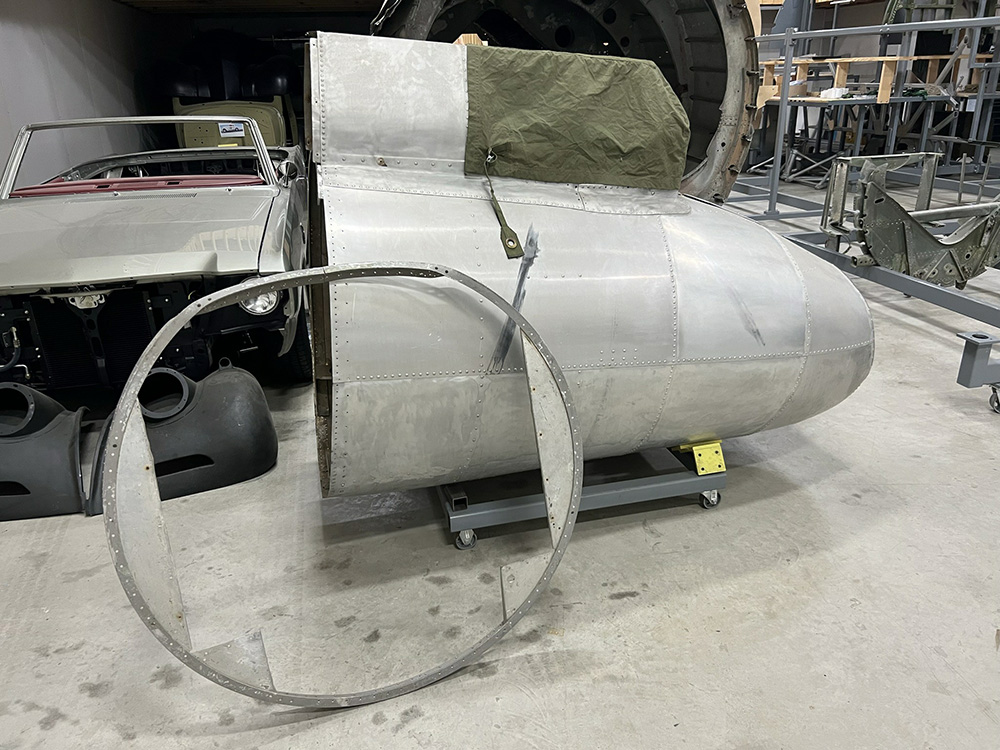
What a coincidence!
Eric found the one station that was missing from the stinger while picking up the first bits of Maid of Athens.
Now to straighten and restore it so we can get to work on the stinger.
Photo taken 28 June 2023.
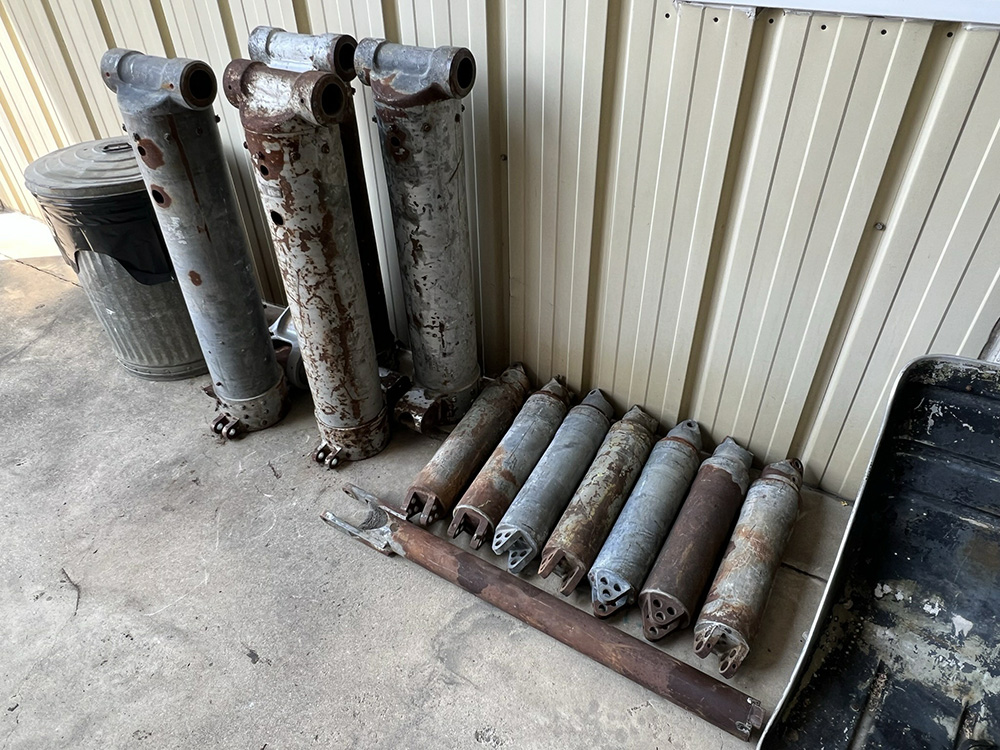

Miscellaneous Boeing B-17 landing gear components that Eric brought back from Texas.
Photo taken 28 June 2023.
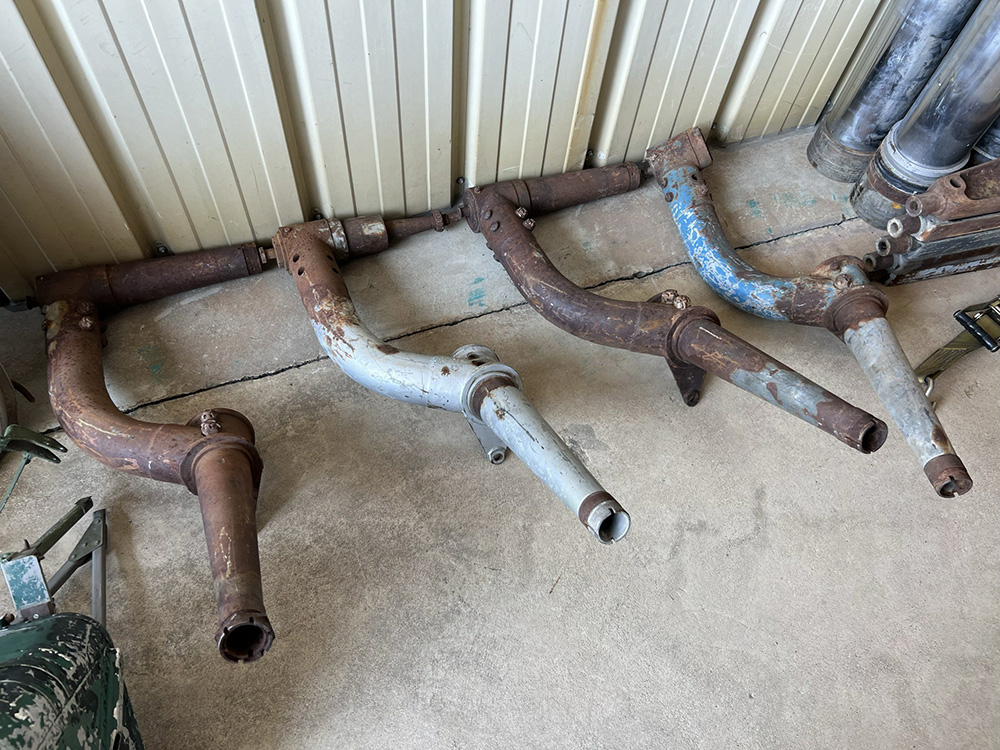
Boeing B-17 tail wheel assemblies that Eric brought back from Texas.
Photo taken 28 June 2023.
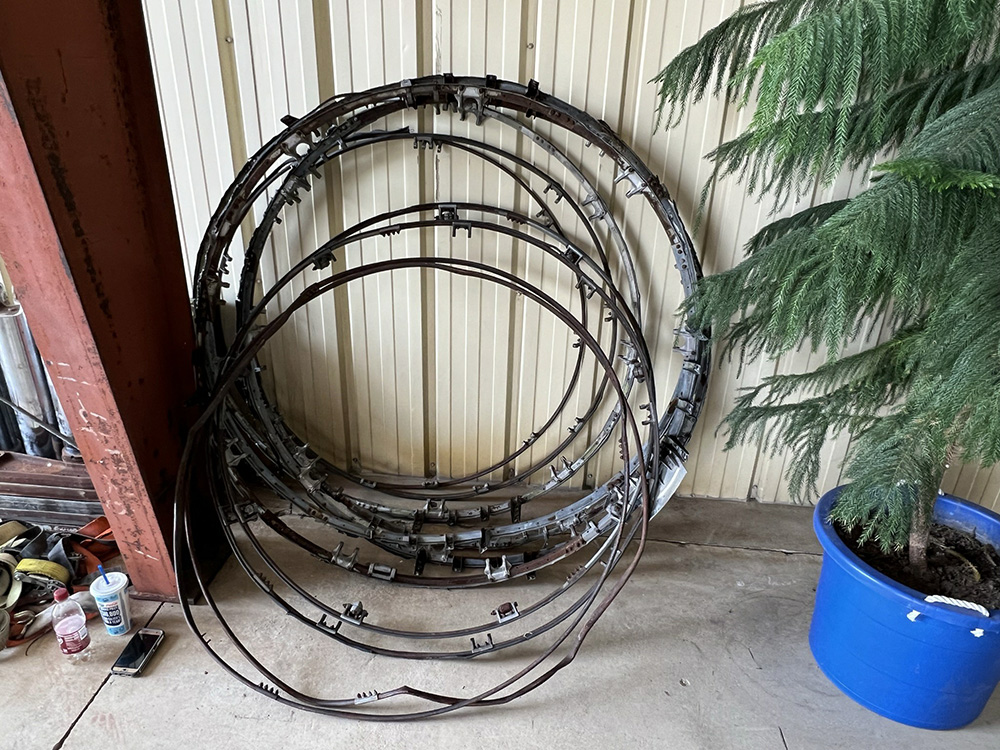
Cowl flap ring assemblies that Eric brought back from Texas.
Photo taken 28 June 2023.

Two more AN-M2 heat shields for the Browning .50 cal. machine guns aboard Lucky Thirteen, donated by our friend Eric Miller of Project Warbird.
When this donation was announced on Facebook, David Ozee of Keller, Texas stepped forth to contribute another heat shield. Thanks David!
Lucky Thirteen carried a defensive armament of twelve machine guns.
Photo taken 28 June 2023.
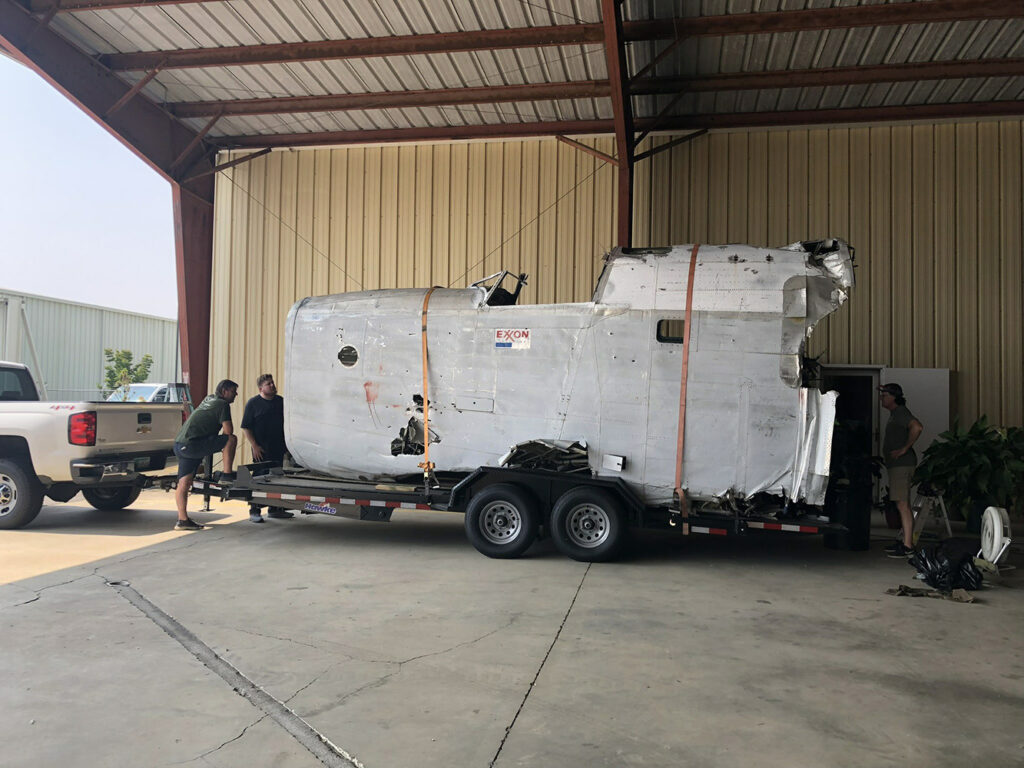
Eric, Gerad, and Ray check out the forward fuselage of Maid of Athens after removing the postwar nose cargo door.
Photo taken 28 June 2023.
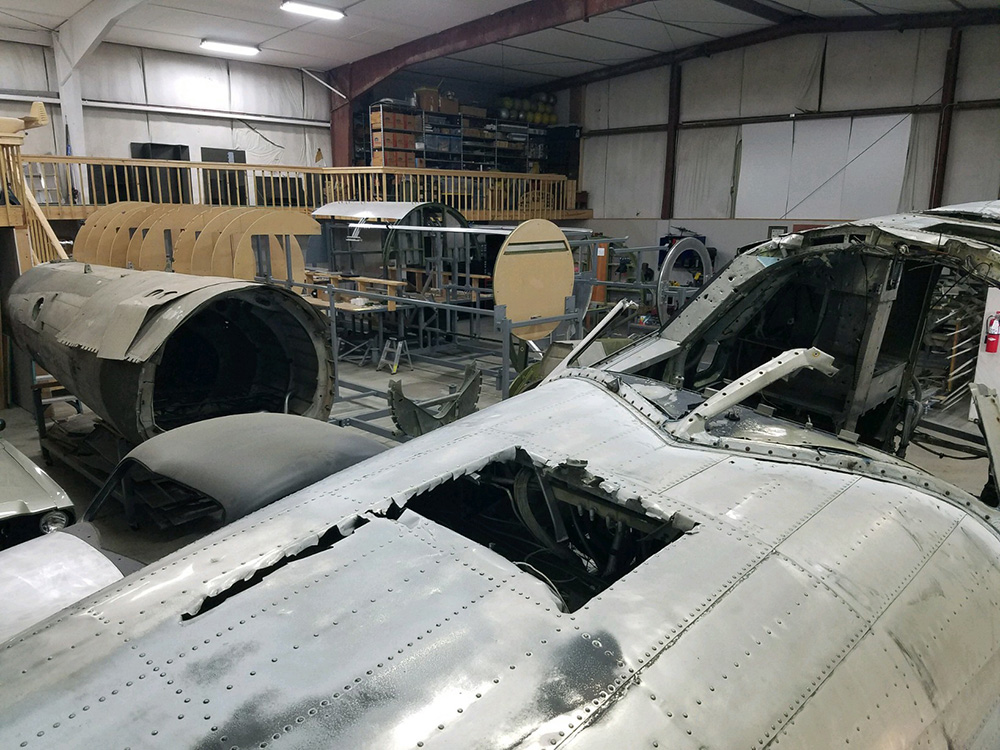
The forward fuselage of Maid of Athens in our hangar at Asheville Regional Airport.
Photo taken 29 June 2023.
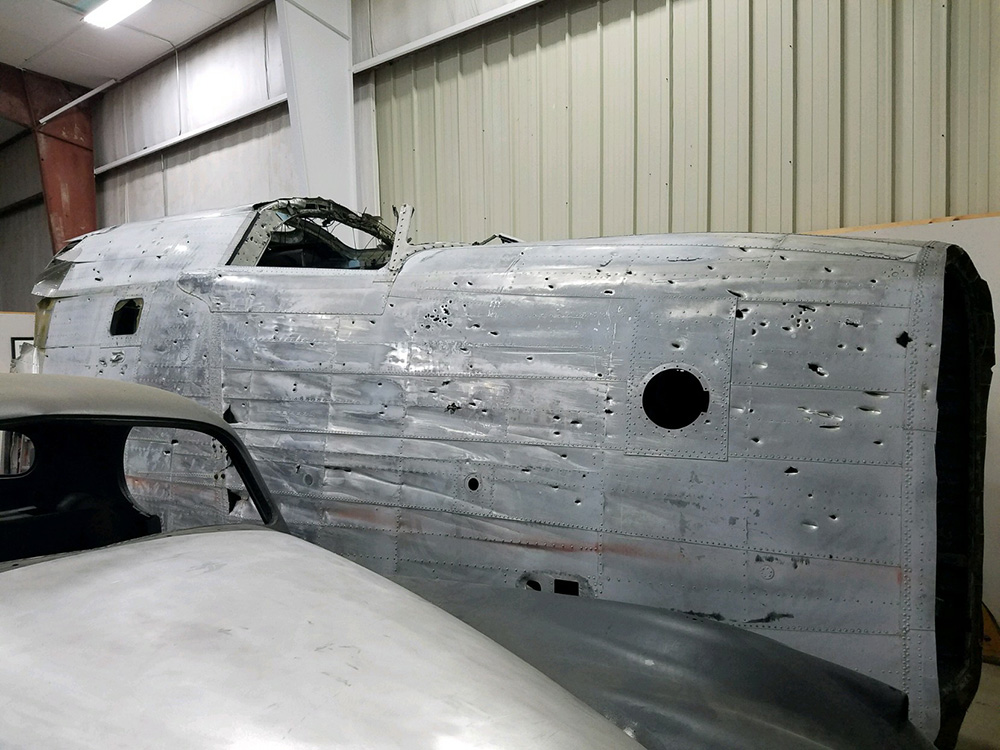
A note to hunters, sportsmen, and the like –
If you come across an airplane wreck in the wild, please don’t shoot it.
Photo taken 29 June 2023.

A Liberator amongst Forts!
Maid of Athens sits in the hangar workshop alongside Lucky Thirteen (left and right) and the Lake Dyke B-17 (center).
Photo taken 29 June 2023.
We have acquired the electrical brush assembly for the Type A-2 Ball Turret on Lucky Thirteen!
We were alerted to this piece by a friend of ours in the UK. Reaching out to the owner, we were able to work out an arrangement, as he was eager to see it restored back to full operation. Let it be said: 𝐰𝐞 𝐰𝐨𝐮𝐥𝐝 𝐧𝐨𝐭 𝐡𝐚𝐯𝐞 𝐛𝐞𝐞𝐧 𝐚𝐛𝐥𝐞 𝐭𝐨 𝐩𝐮𝐫𝐜𝐡𝐚𝐬𝐞 𝐭𝐡𝐢𝐬 𝐩𝐢𝐞𝐜𝐞 𝐰𝐢𝐭𝐡𝐨𝐮𝐭 𝐲𝐨𝐮𝐫 𝐝𝐨𝐧𝐚𝐭𝐢𝐨𝐧𝐬. Our sincere thanks to all of you who have contributed to Hangar Thirteen so that we may rebuild the bomber’s turrets.
To recap some history:
The USAAF entered the Second World War without a powered gun turret and had to rely on the British to advise on the development of such systems. Various companies were assigned individual airframes and Sperry Gyroscope of Brooklyn, New York was given the Boeing B-17 as its subject. While Sperry designed the A-1 Upper and A-2 Lower turrets, production of these units was done elsewhere: Steel Products and Engineering (SPECO) of Ohio for the A-1 and Briggs Manufacturing of Michigan for the A-2. They were both later supplemented by Emerson Electric of Missouri.
The Type A-2 Ball Turret entered service with B-17E 42-2505 and stayed in service until B-17G 42-31554, after which it was replaced by the Type A-2A. The two are easily distinguishable from one another: the A-2 had a large, heavy frame with an external oxygen tank, the A-2A had a thin frame with a low center of gravity and a direct oxygen feed which negated the external bottle.
There are a great many myths and misunderstandings about the ball turret, and this is particularly true regarding the differences between models. All surviving B-17Gs today were originally equipped with A-2As. No A-2A turret ever carried an external oxygen tank, nor did the B-17 ever use external ammunition cans for its ball turret (a feature of the short-lived A-13A turret used on B-32s and late-B-24s).
We know from surviving wreckage that Lucky Thirteen carried a ball turret built by Briggs. This was indicated by the gray color of the ball’s interior, as Emerson-built turrets had dark green interiors. Another difference was the trunnion/hanger assembly: Briggs turrets were olive drab and Emerson turrets were dark green. An original trunnion/hanger has been offered to us at 25,000 USD (a total we have yet to meet). Similarly, the Planes of Fame Museum in Chino, California generously allowed us to 3D scan an A-2 ball they have in storage, since we have been unable to locate an example for the airplane. As such, the brush assembly was the only major body component we had not found a lead on. We were extremely fortunate that, not only is this piece from a Briggs, but it was in service during the same period as Lucky Thirteen as well.
This brush assembly came from a midair collision which occurred over RAF Great Ashfield on 26 September 1943 – just 20 days after Lucky Thirteen was shot down.
Dorsal Queen (42-30264) and Raunchy Wolf (42-3290) of the 385BG were in a holding pattern over the field, having returned from a strike, when Raunchy Wolf collided with Dorsal Queen. The official report speculates that a frosted windshield obscured the pilots’ vision. Raunchy Wolf lost her left wing and Dorsal Queen her tail, both spiraling out of control. The only survivor was SSGT John J. Adams, tail gunner on Dorsal Queen.
We are not aware as to which of the two bombers this piece came from.
As such, we wish to honor the crews of these aircraft with the restoration of this piece:
Dorsal Queen (42-30264)
1LT Paul M. Yannello (P)
2LT Frederick E. Wilson, Jr. (CP)
2LT Charles A. Wardle (B)
2LT Guilford N. Black (Nav)
TSGT Walter F. McMillan (Eng)
TSGT Stanley J. Gula (RO)
SSGT Lawrence C. “Pi-Yi” Kern (BT)
SSGT Edgar L. Seitz (LW)
SSGT Marion E. McGinnis (RW)
SSGT John J. Adams (TG)
1LT Sidney S. White (Obs)
Raunchy Wolf (42-3290)
1LT John T. Keeley, Jr. (P)
1LT Harry R. Coomes (CP)
1LT Theodore R. “Ted” Rouse (B)
1LT Arthur R. Moore (Nav)
TSGT Ledger D. Pontius, Jr. (Eng)
TSGT Samuel B. Rochester (RO)
SSGT Robert L. Banner (BT)
SSGT Raymond H. Shepherd (LW)
SSGT Douglas Binford (RW)
SSGT Edward Osbron (TG)
Our sincere thanks to Colin Waterworth, Roger Pickett, and to our financial supporters for making this happen. The 384th Bomb Group (Lucky Thirteen’s unit) patch was emblazoned with the words “Keep the show on the road.” Let us do that. With your support we can acquire the missing body components and rebuild these turrets back to working condition.
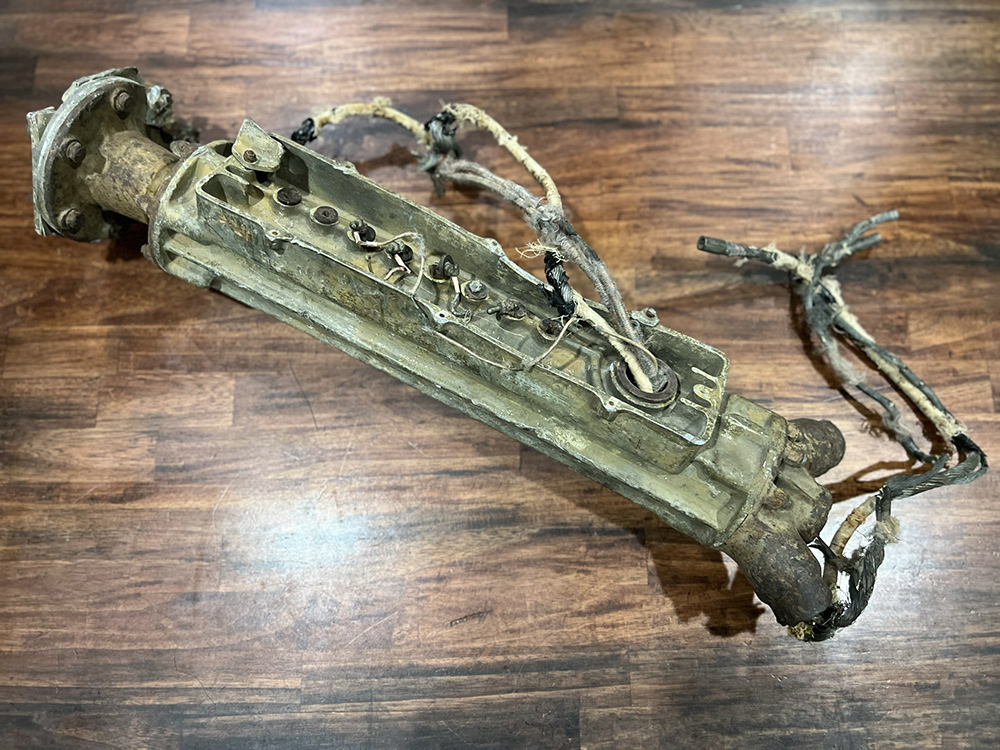
The newly arrived electrical brush assembly for the Type A-2 Ball Turret.
The cover is missing from this example but we believe that we may have a lead on a replacement.
Photo taken 11 June 2023.
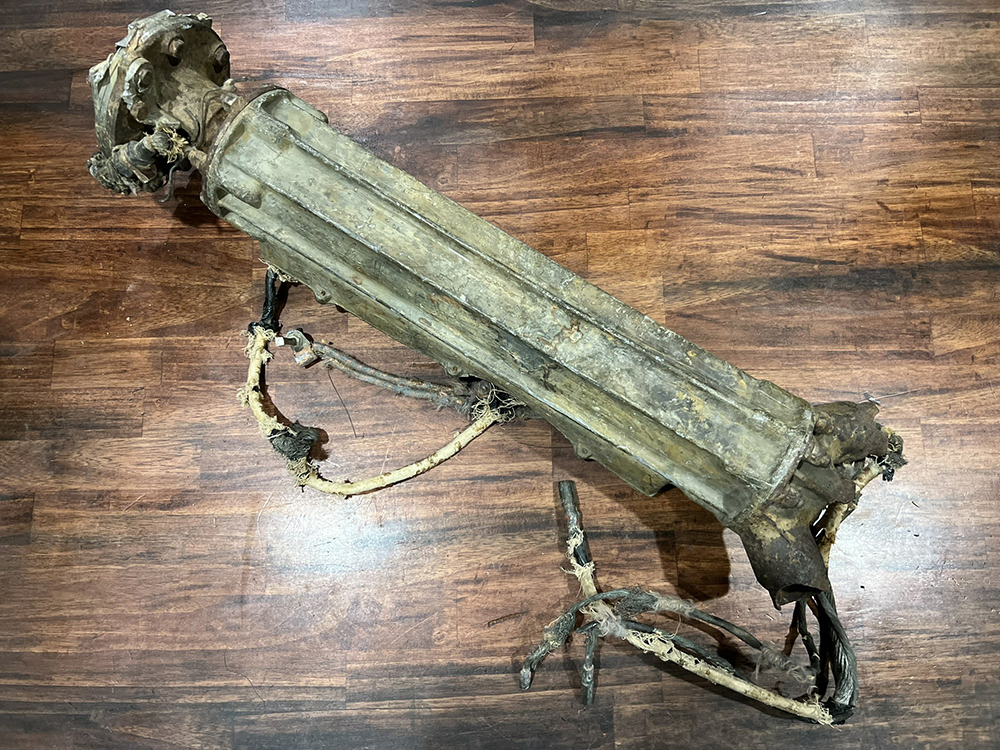
The backside of the newly arrived electrical brush assembly for the Type A-2 Ball Turret.
The brush assembly is where the the turret received its electrical power from the aircraft. As such, this piece is critical to rebuilding the turret to operational condition.
There are no functional examples of the Type A-2 Ball Turret surviving today – all are either A-2As or A-13As.
Photo taken 11 June 2023.

The Type A-2 Ball Turret can be easily identified outside the airplane by the plastic caps which cover its sides.
We are currently attempting to procure a pair of these for Lucky Thirteen, having been in talks for over a year now.

A manual illustration of a Type A-2 Ball Turret.
The brush assembly has been highlighted in red.
The hanger and trunnion assembly has been highlighted in blue. A trunnion/hanger has been offered to us for the price of 25,000 USD, if we can raise the money.

One of the components 3D scanned using the Type A-2 Ball the Planes of Fame Museum has in storage.
The piece you see here is the ball’s left bell assembly.
Despite popular misconception, scans are not enough to cast a new part. The parts must be painstakingly reverse engineered, and our volunteers must work carefully with the volunteers at Planes of Fame to doublecheck measurements for tiny details that a scan might not pick-up or recognize.
When we first called Planes of Fame about the ball, they immediately answered “It’s not for sale!” Ha!
Who knows, maybe one day they’ll change their mind!

Manual illustration of the brush and hanger assembly. The cover and retainer mounting plate are both missing from our brush assembly.
The secret to the turret’s power is the collector ring assembly: the long tube piece on the far right.
Power from the airplane goes to this piece, which is then picked up by wires which ‘brush’ against the rings. This gives the turret power while allowing it to move unencumbered.
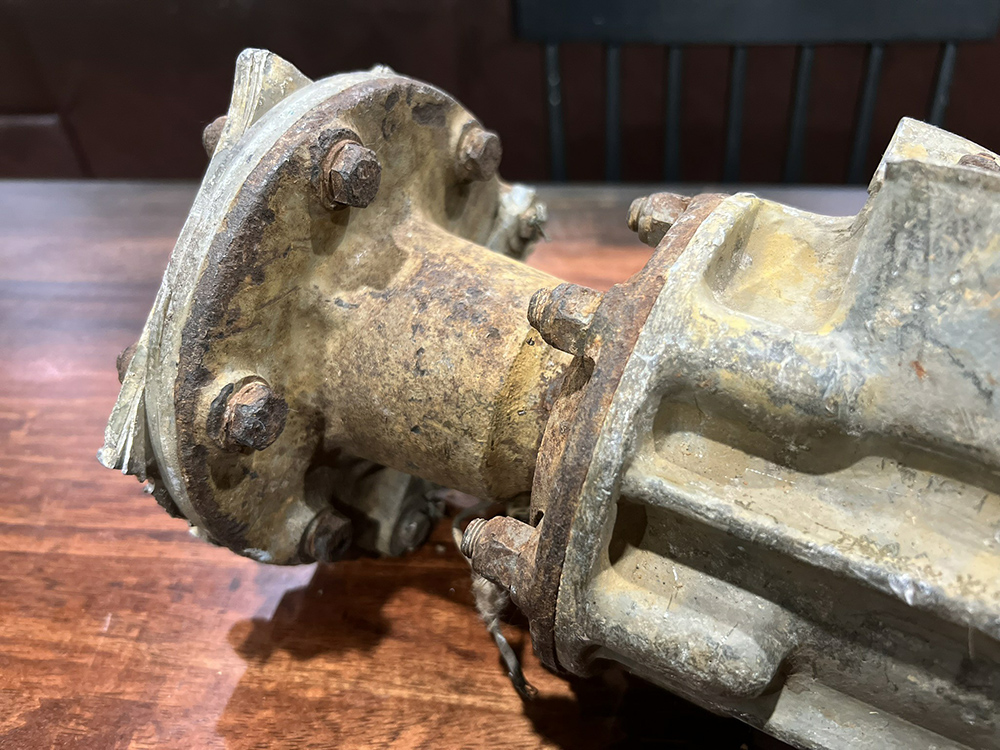
The upper trunnion which mounts the Type A-2 Ball Turret to the B-17.
Not visible in this photo is where the power from the airplane enters the assembly.
Photo taken 11 June 2023.

A portion of the hanger assembly is still attached to the brush assembly.
The ball turret’s hanger was made of metal tubing, with the turret’s main power exiting near the elbow of the left tube. A thick piece of ribbed, cloth conduit ran the power from the hanger to the ball itself.
Photo taken 11 June 2023.
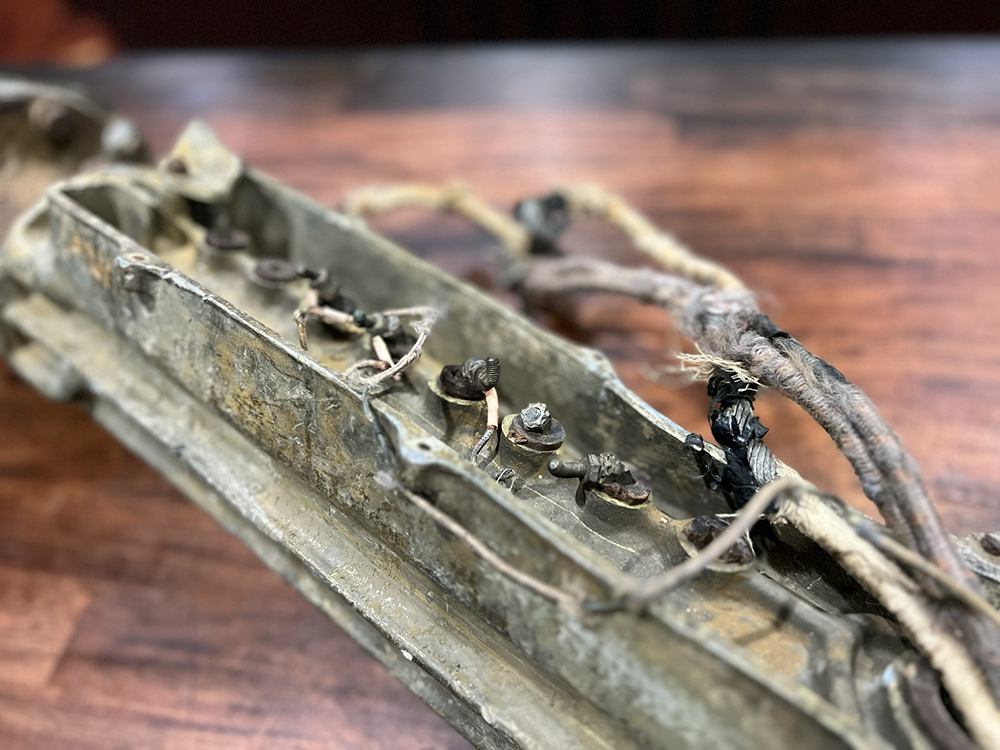
A closeup of the uncovered brush assembly.
While the brushes are all bent from the impact of the collision, the assembly is nevertheless largely complete. Each brush is connected to a wire which feeds out the bottom of the assembly, connecting to the large conduit which provides power to the ball.
These brushes power the turret’s motor, gun-firing solenoids, push-to-talk button, fire cut-off cam, flightsuit heater, and computing gunsight.
Photo taken 11 June 2023.
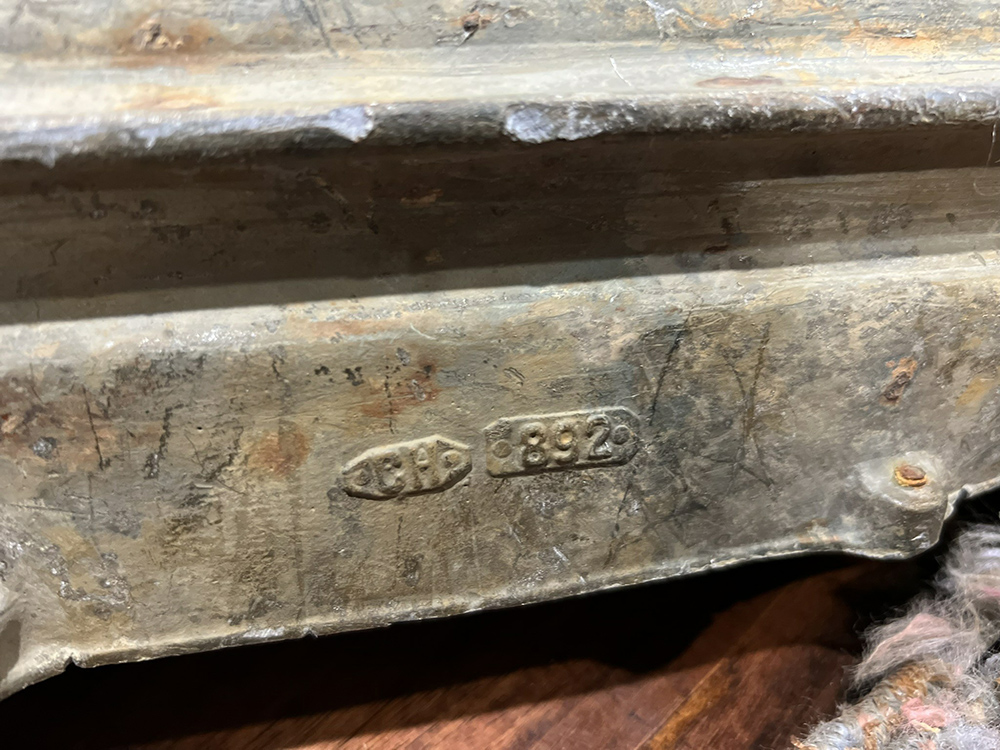
A closeup of the part number. This number, 892 – along with the olive drab paint scheme – confirms that this is a Briggs-built ball turret.
The Emerson variant of this piece was part no. 205701
Photo taken 11 June 2023.

A manual photo showing the Type A-2 Ball Turret aboard a Boeing B-17E. The fact that this is an E-model can be ascertained by the lack of armor plating around the waist gun windows.
The large conduit which runs from the hanger to the ball is visible here, as is the brush assembly’s cover plate.
The box on the hanger assembly is a spare parts/accessory box. If you have access to one of these, please let us know!
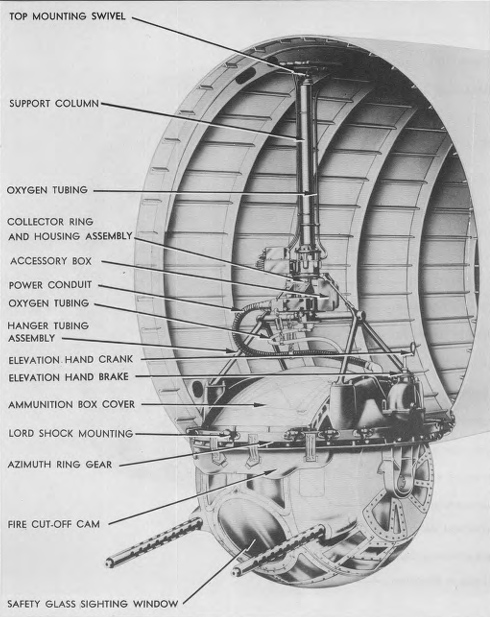
The Type A-2A Ball Turret, which replaced the A-2 early in the G series.
With the exception of those that were converted to not carry turrets, all surviving Boeing B-17Gs today should be equipped with this type of ball.

The crew of Raunchy Wolf seek shade under the wing after the infamous Schweinfurt-Regensburg strike of 17 August 1943. Raunchy Wolf was one of 146 aircraft which bombed the Messerschmitt factories of Regensburg and flew on to occupied-Algeria for a brief stay with the 12AF.
Lucky Thirteen was also a veteran of this strike, being one of the 230 bombers which attacked the ball bearing plants of Schweinfurt.
Note the Emerson-built top turret and high camouflage demarcation line. Like Lucky Thirteen, Raunchy Wolf was a Douglas-built B-17F.
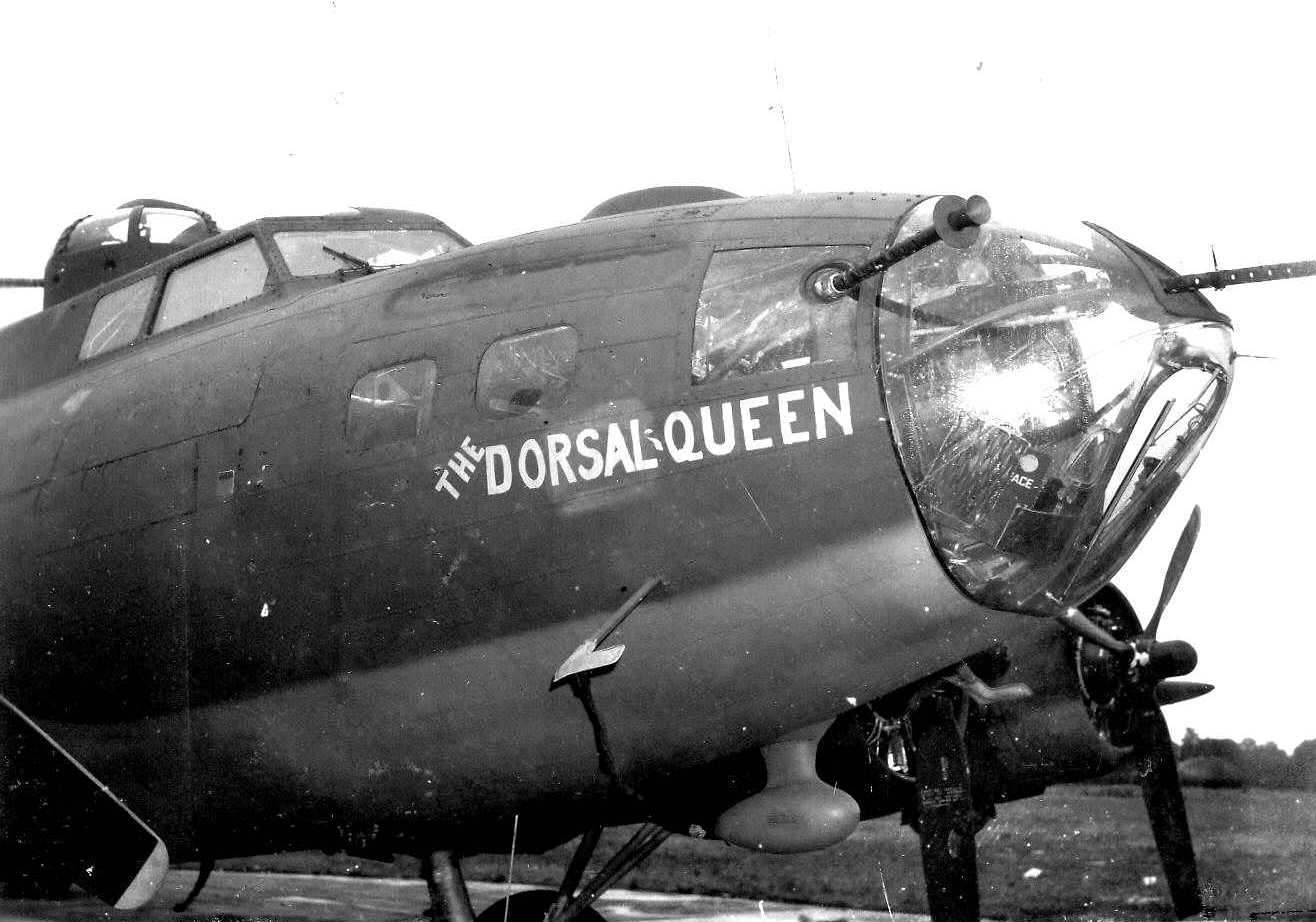
Dorsal Queen, named in reference to the Boeing B-17’s large tail.
Note the unusual flash suppressors on the cheek gun – a unique characteristic of many 385BG B-17Fs.
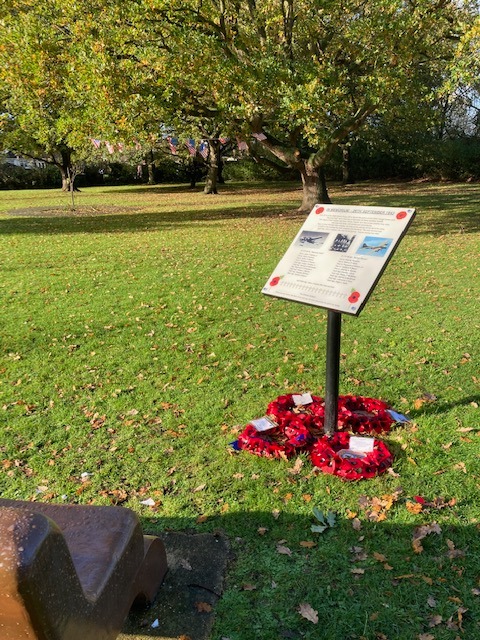
The memorial to the crews of Raunchy Wolf and Dorsal Queen.
It is our sincere hope that our work brings honor to their memories.
This donation is a big one:
A Type M-2 Chemical Handling Trailer.
Ronald La Curan is one of our long-time supporters, having played a huge role in completing the flare gun stowage assembly for Lucky Thirteen, and being part of the group which located our NOS Type C-1 Instrument Testing Cart. In 2021 he got this M-2 Chemical Warfare Trailer from Mifflinburg Body & Gear Ltd. Co. near Virginia Beach. We chatted regularly about the piece and even entertained purchasing an M-5 Bomb Trailer in Florida to serve as a companion (which did not work out).
Well, you can imagine my shock when Ron offered to donate the trailer to Hangar Thirteen back in March. It took us some time to arrange a trip to pick it up, but it is finally here. Thanks Ron!
Some history:
The M-2 Chemical Warfare Trailer and the M-5 Bomb Trailer are so similar in appearance that there are even a few museums that have M-2s displayed as M-5s. In reality, these units were purpose-built: the M-2 for the US Army Chemical Warfare Service and the M-5 for the US Army Ordnance Department.
The Chemical Warfare Service (now the US Army Chemical Corps) was formally established on 28 June 1918 in reaction to the use of poison gas in the Great War. The CWS managed to build a stockpile of chemical weapons throughout the Interwar period and Second World War, and though there was serious consideration given to the use of such weapons against Japan in 1944-1945, the US and its Allies never resorted to their use. Still, the CWS saw extensive service during the war providing smoke and incendiary material, such as white phosphorous and napalm.
The M-2 Trailer was designed and built by Saginaw Stamping & Tool of Michigan. In appearance it was similar to the M-5 Trailer, but was 6 inches thinner, 16.5 inches shorter, and 1,000 lbs lighter. The biggest difference was that the M-2 had a flat deck, while the M-5 had notched deck designed to keep bombs from rolling. The M-5 also featured lumps on its toolbox onto which the fins of bombs could be stowed when not attached to the bombs.
This particular unit saw some postwar service as evidence by a layer of yellow paint under its outermost coat of OD. Said OD was doubtless painted on by a previous owner as the original paper chart in the toolbox has been covered in overspray.
The trailer has been placed into temporary storage at a vintage car restoration shop owned by a friend of Ray’s. While work on the airplane will take priority, we will work to restore this piece as time permits. We have already recreated the missing dataplates on the computer and are now working to gather blueprints and reference material.
Special thanks to Ron La Curan for this awesome donation!
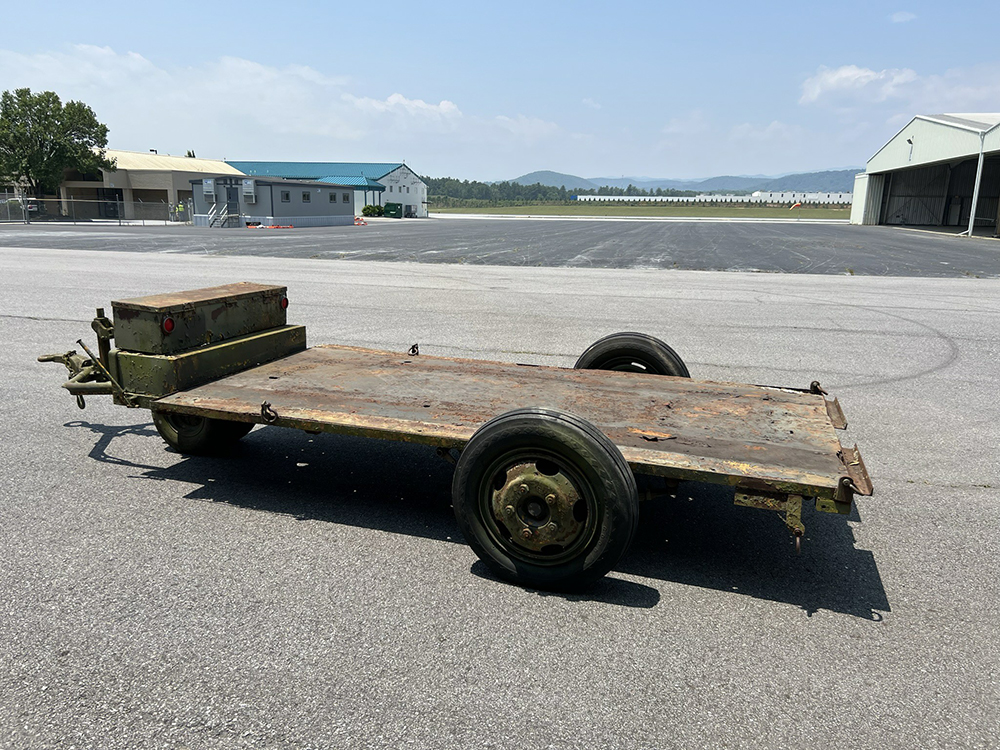
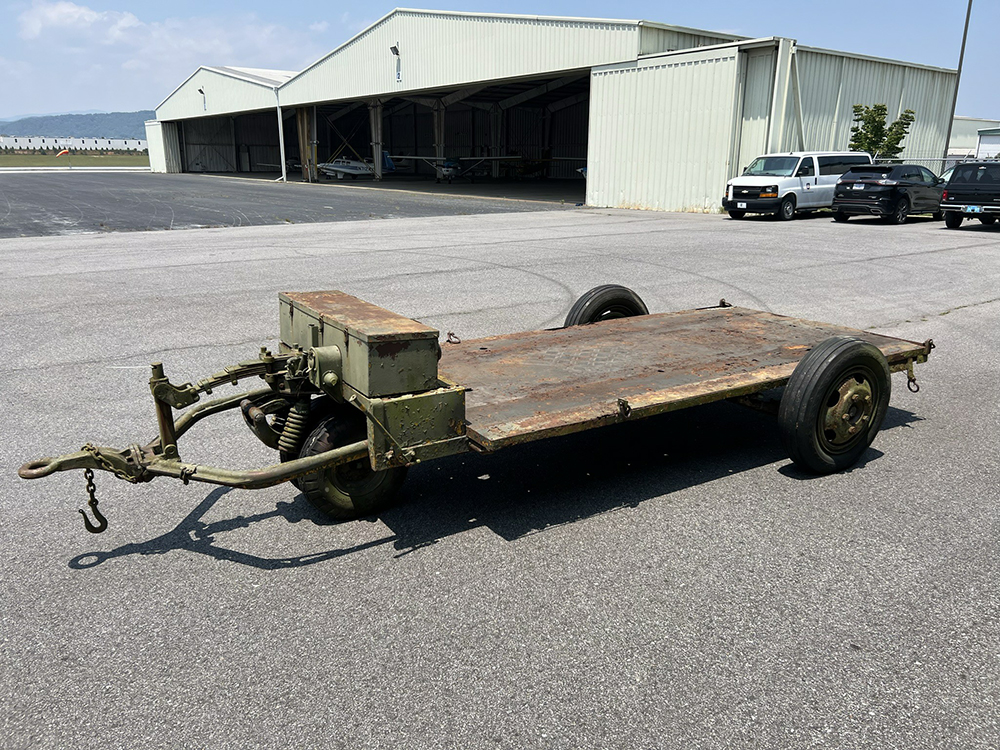
Ron’s newly-donated Type M-2 Chemical Handling Trailer.
Photo taken 8 June 2023.
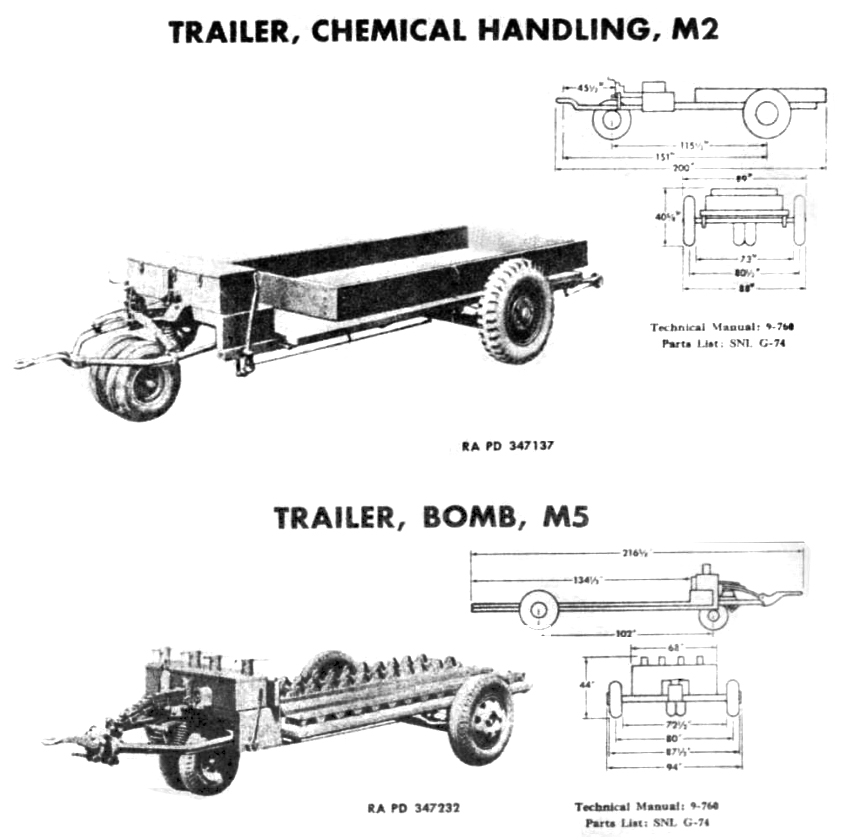
Excerpts from the Army index comparing the M-2 and M-5 trailers.
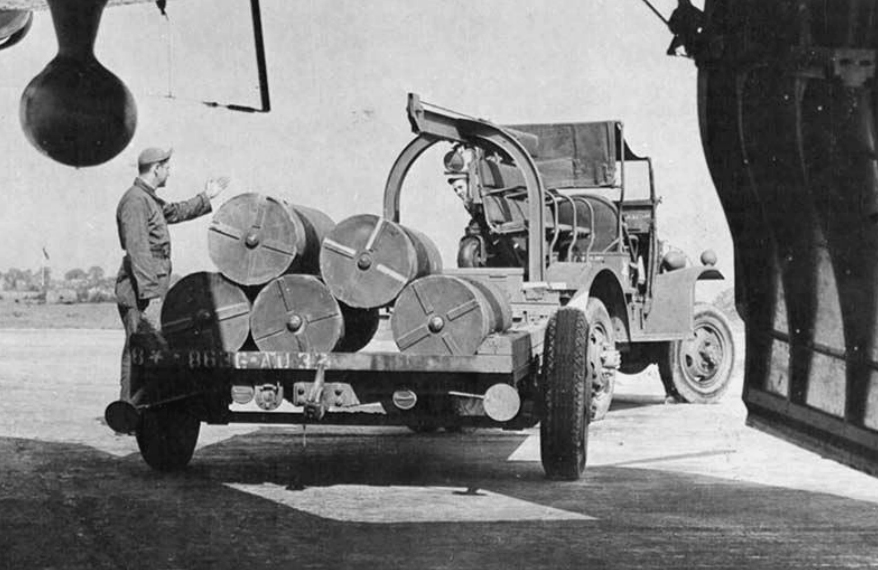
Leaflet laden ‘Monroe Bombs,’ named for CPT James Monroe of the 305BG, are loaded aboard a Boeing B-17G.
This is a rare photo showing an M-2 Chemical Handling Trailer in action.
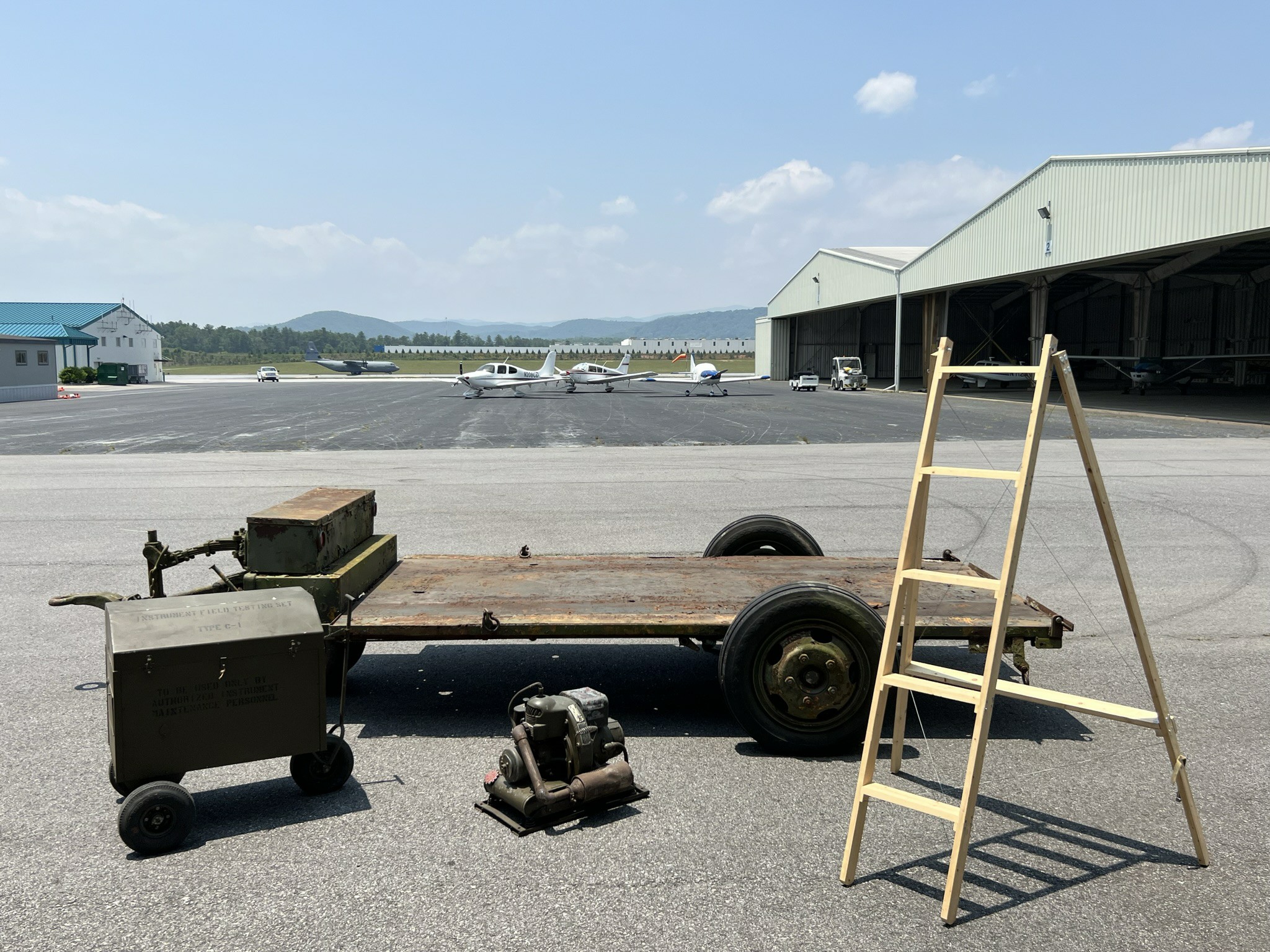
The newly-donated M-2 Chemical Handling Trailer is displayed with other ground support equipment in Hangar Thirteen’s collection.
Note the Lockheed C-130 on the runway. This aircraft was practicing touch-and-goes.
Photo taken 8 June 2023.
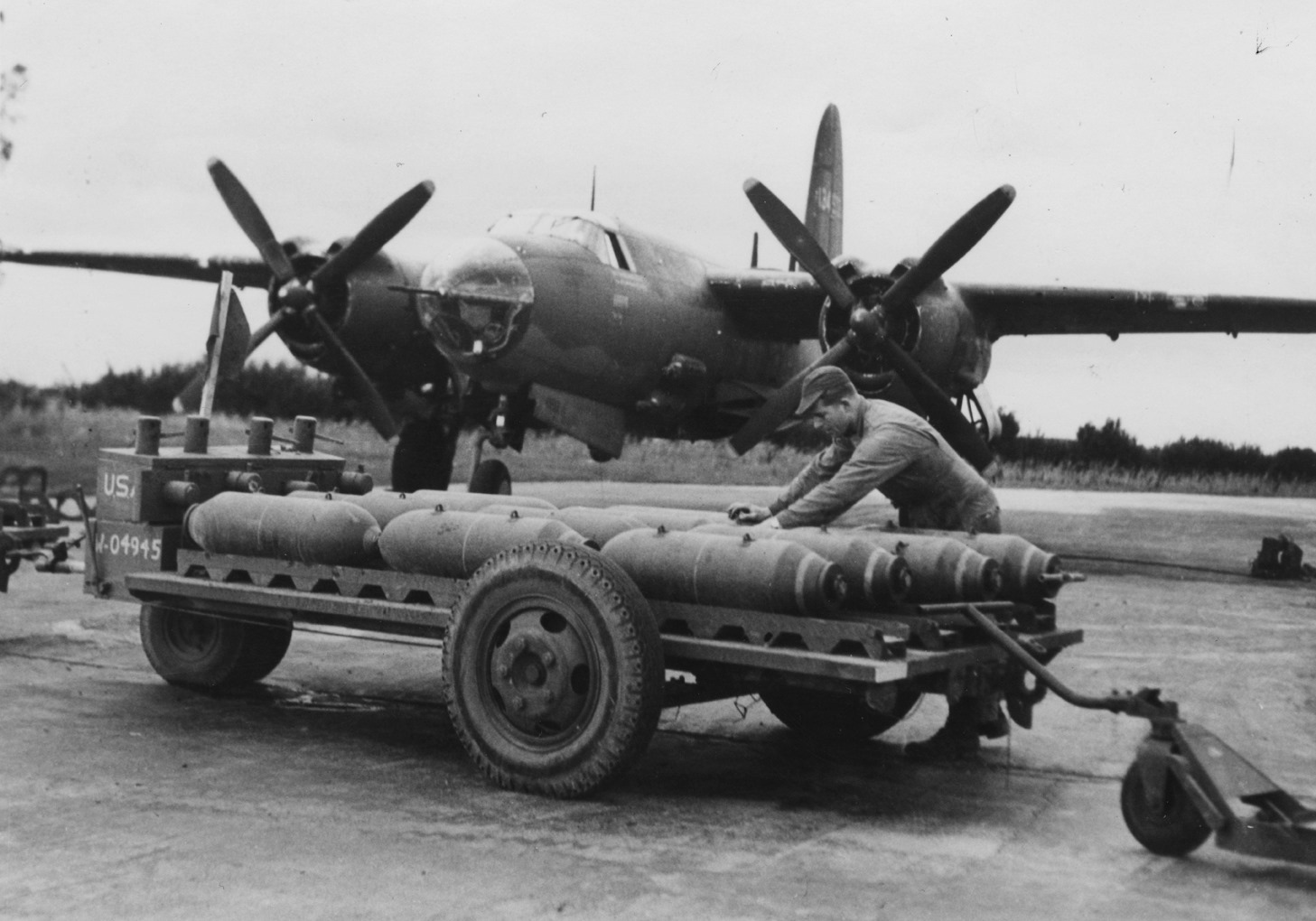
Armorers of the 323BG prepare to load a Martin B-26 at RAF Earls Colne.
Note that they are using a Type M-5 Bomb Trailer.
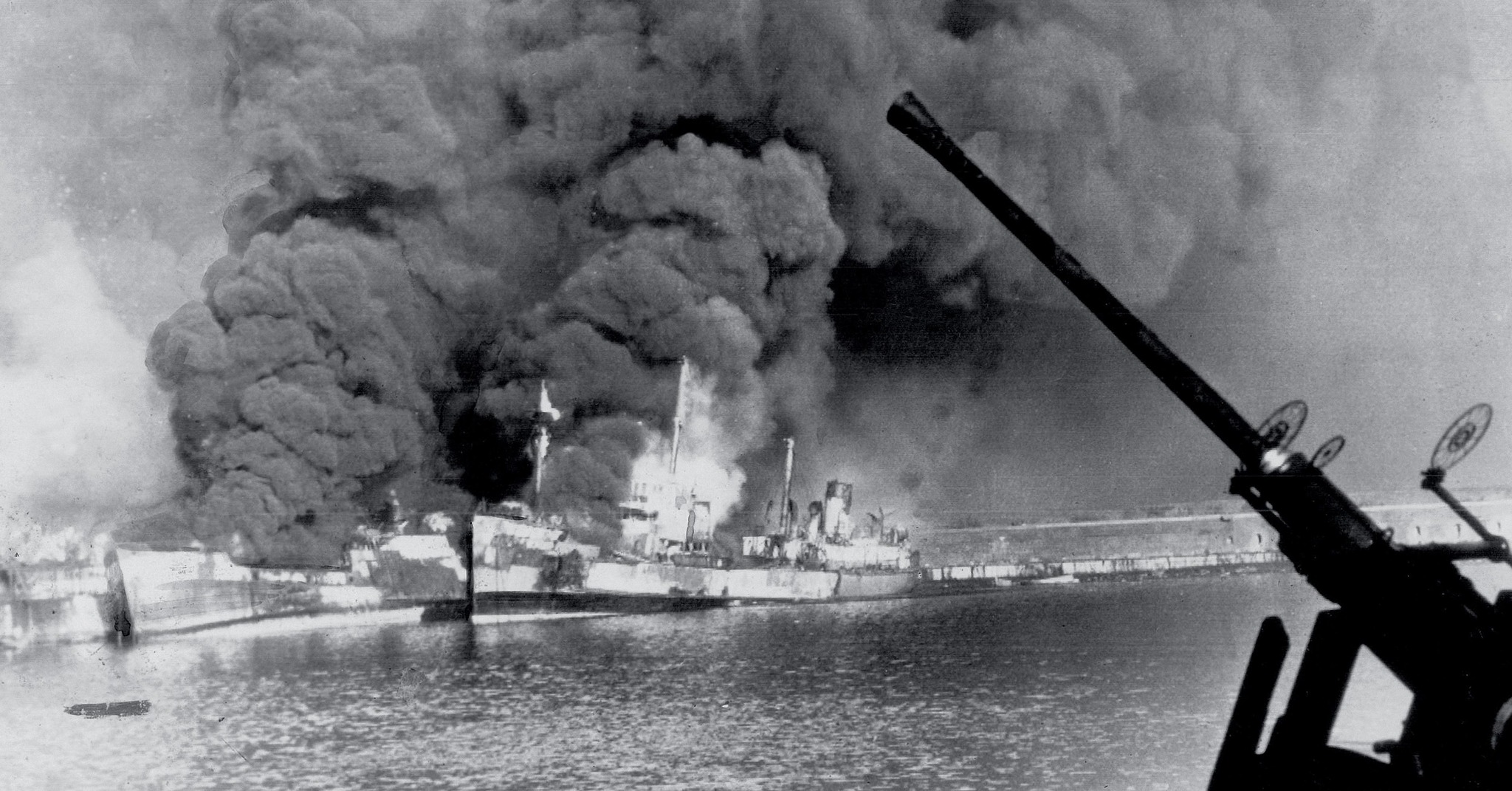
On 2 December 1943, 105 Ju-88s bombed Allied shipping moored in the Italian harbor of Bari, sinking 28 vessels and killing some 2,000 servicemen and civilians. One of these vessels was the USS John Harvey, a Liberty ship whose cargo included stockpiles of Type AN-M47 bombs filled with mustard gas. The ordnance was intended for the US 15AF as a precaution – if the Axis powers were to use chemical weapons, the Allies were ready to respond in kind.
The release of mustard gas into Bari harbor had a catastrophic effect, particularly since the Allied nations did not want the news of the weapon’s presence to be publicly known. Confirmation of the mustard gas was made by LTC Stewart F. Alexander, who made detailed reports on the compound’s ability to kill white blood cells. After the war, his findings formed the basis for chemotherapy treatments which slow the overproduction of white blood cells in various cancers.

A Consolidated B-24M Pathfinder drops AN-M47s filled with chemical smoke agents alongside its standard payload on the railyards of Mühldorf, Germany. This area connected the factories of Munich and Töging am Inn with the concentration camp complex at Dachau.
Pathfinder bombers used Type H2X Radar Sets in place of their ball turret positions. In poor weather, the operator located the target by calculating its position off radar identifiable positions (such as mountains, rivers, and lakes). The target was then marked with smoke bombs so that following bombers would know where to aim.
Photo taken 20 April 1945.

Boeing B-17Gs of the 303BG drop loads of AN-M47 incendiary bombs on the Daimler-Benz engine factory of Ludwigsfelde, Germany.
The first use of napalm-based incendiaries occurred on 6 March 1944, when the US 8AF launched 504 B-17s against Berlin, with another 226 Consolidated B-24s bombing nearby Ludwigsfelde.
Photo taken 6 August 1944.

Hangar Thirteen’s AN-M47 chemical bomb next to the tail gun assembly for Lucky Thirteen.
Special thanks to Eric Miller of Project Warbird for his help with acquiring this piece!
Photo taken 23 April 2023.
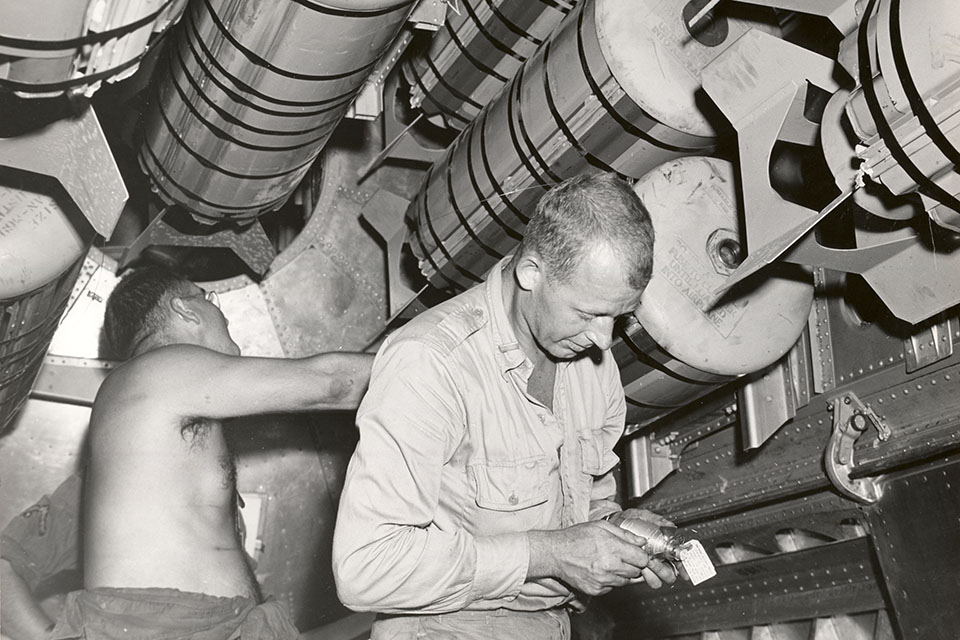
Ground crews load AN-M19 incendiary clusters aboard a Boeing B-29. Each cluster contained 38 six lb napalm incendiary sticks.
The US 20AF’s firebombing campaign against Japan throughout 1945 was terrible in its effectiveness. The strike on Tokyo on 9 March 1945, for example, remains the deadliest conventional bombing raid in history, killing nearly 84,000 people.
Similar tactics were used in the Korean War in reaction to Communist China’s entry into the conflict, starting on 5 November 1950. Though casualty numbers are not known, reconnaissance showed that 70% of North Korea’s infrastructure was eliminated by the end of the month. Strikes against China itself, however, were strictly prohibited.
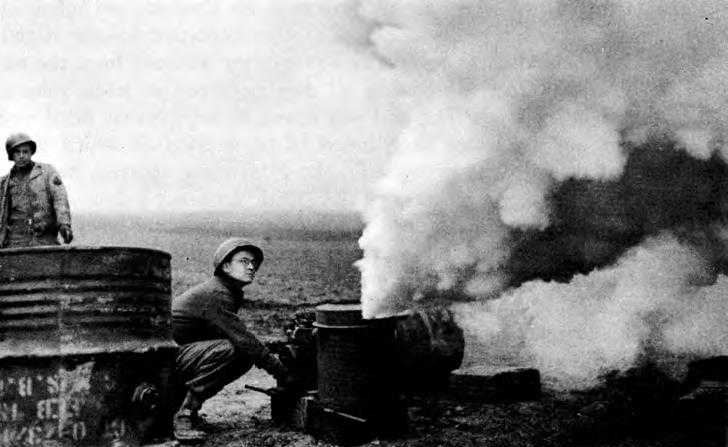
US Army CWS personnel light smoke generators to conceal the pontoon bridges erected across the Rhine River in March 1945.
The smoke from these units helped prevent German aircraft from effecting targeting the area.
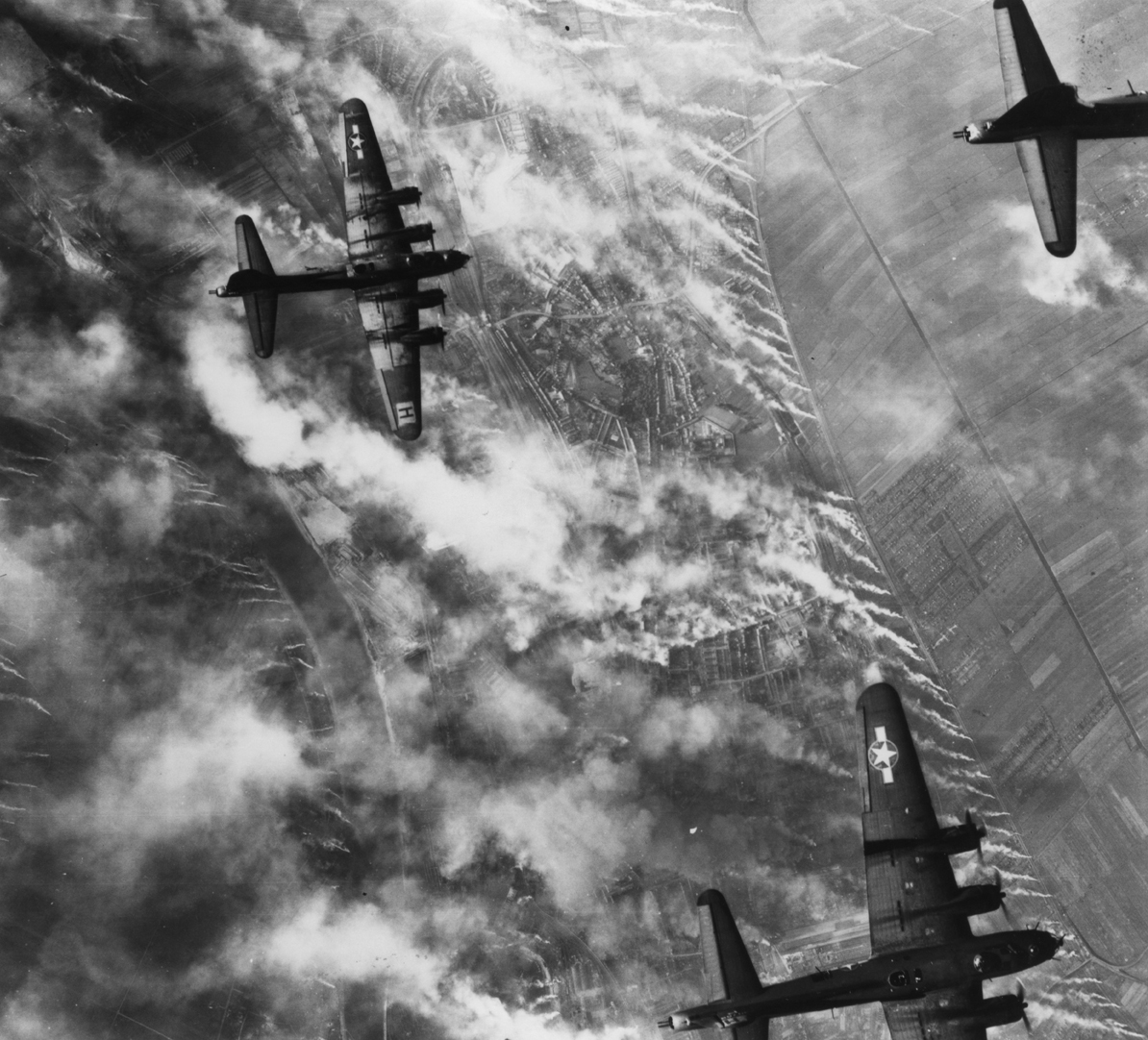
Boeing B-17Fs of the 388BG fly over the railyards of Bremen, Germany, the target being obscured by smoke screens.
Photo taken 8 October 1943.
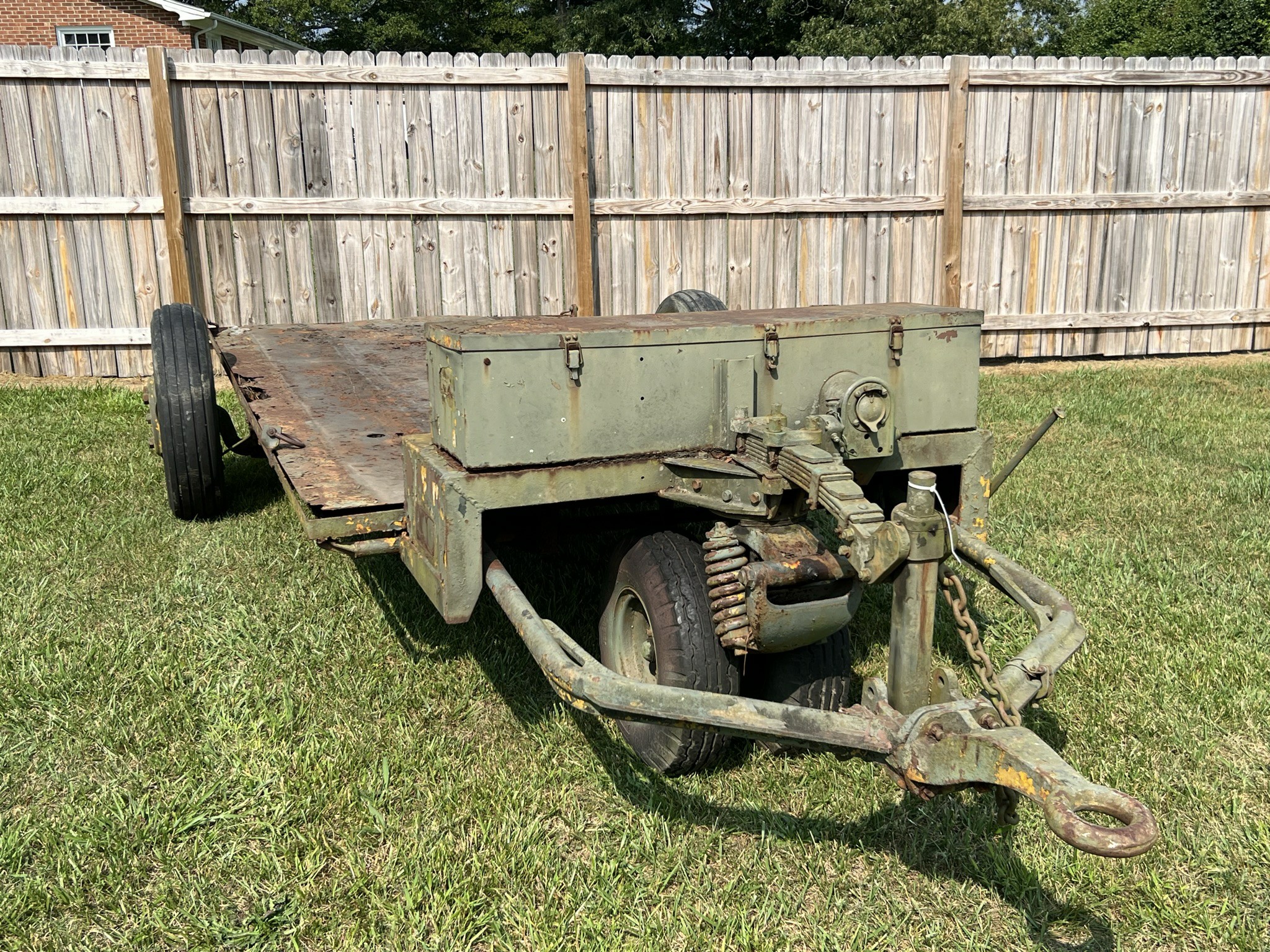
The newly-donated M-2 Chemical Handling Trailer safely stowed in its storage area behind the car restoration shop.
Photo taken 8 June 2023.

A parade in Saginaw, Michigan shows off the M-5 Bomb Trailer and M-2 Chemical Handling Trailer types locally made for the war effort.
